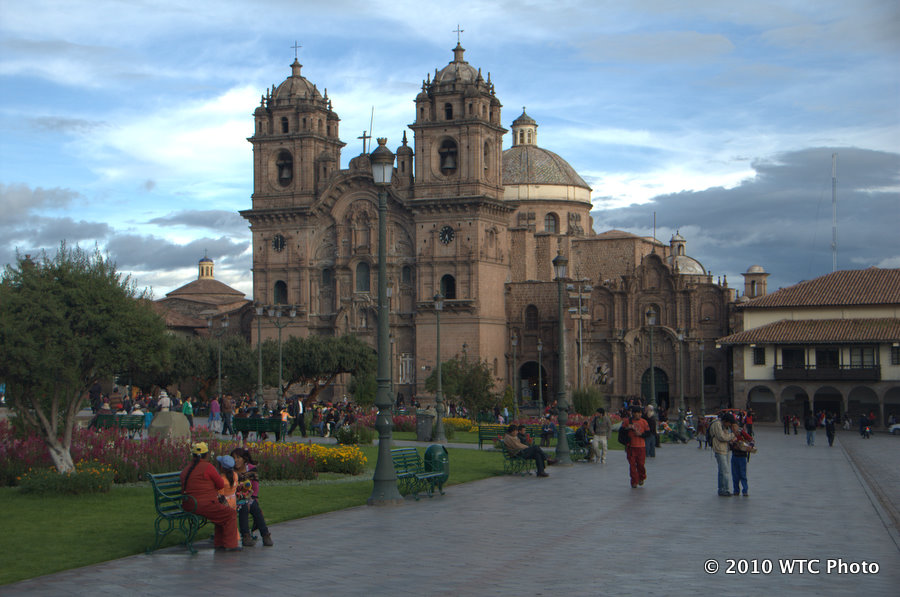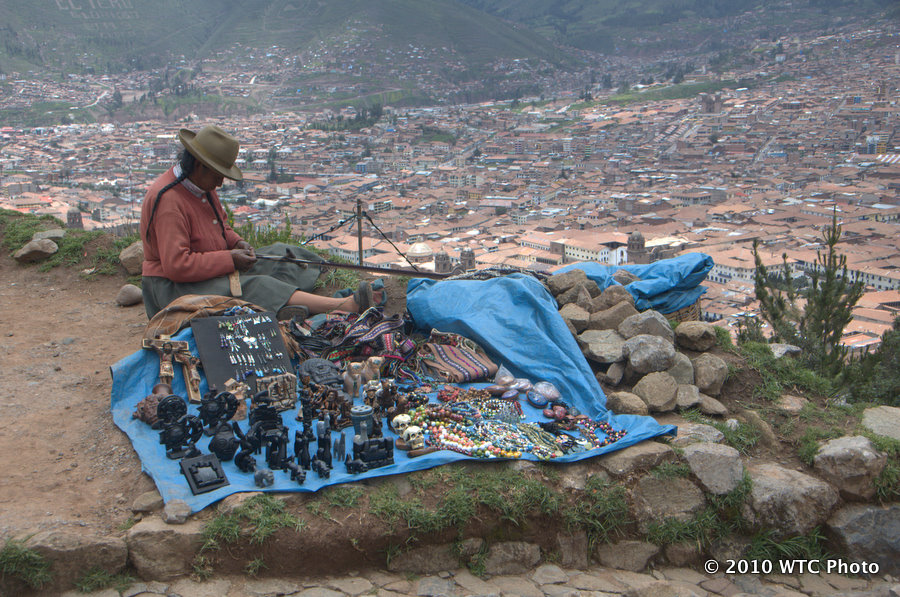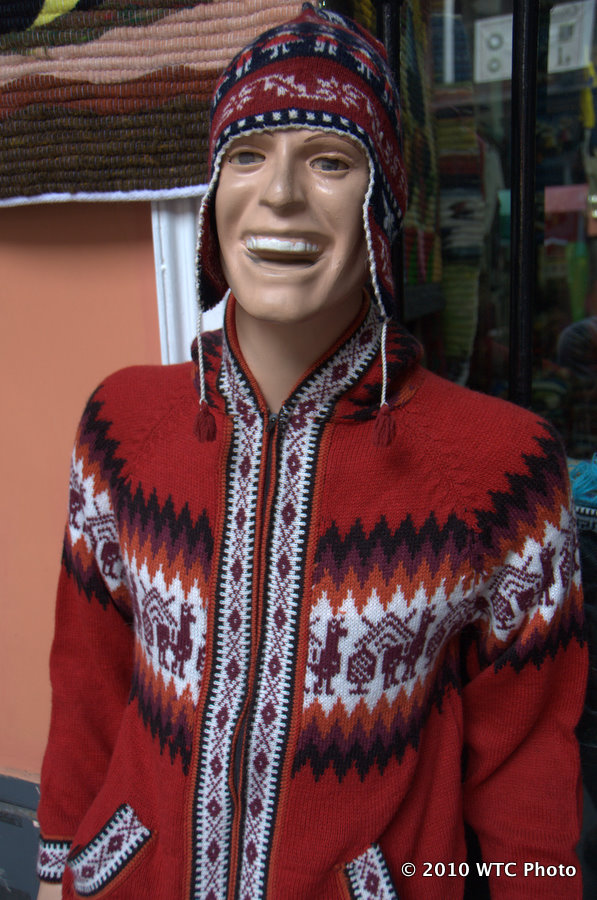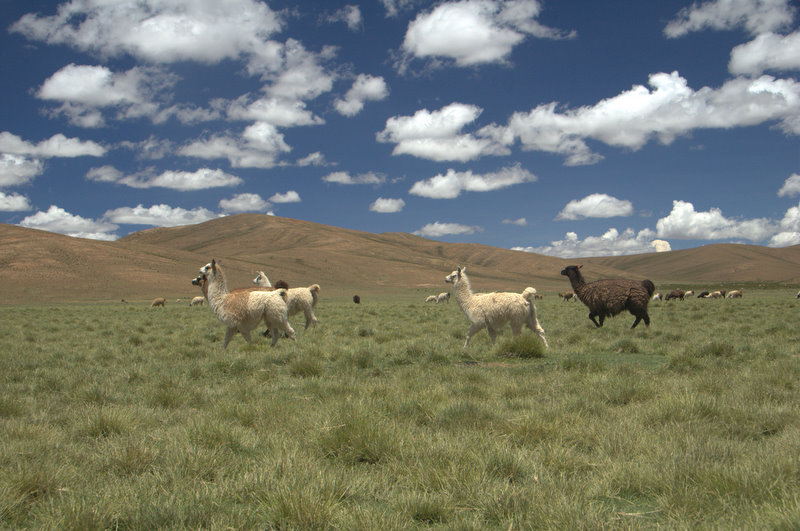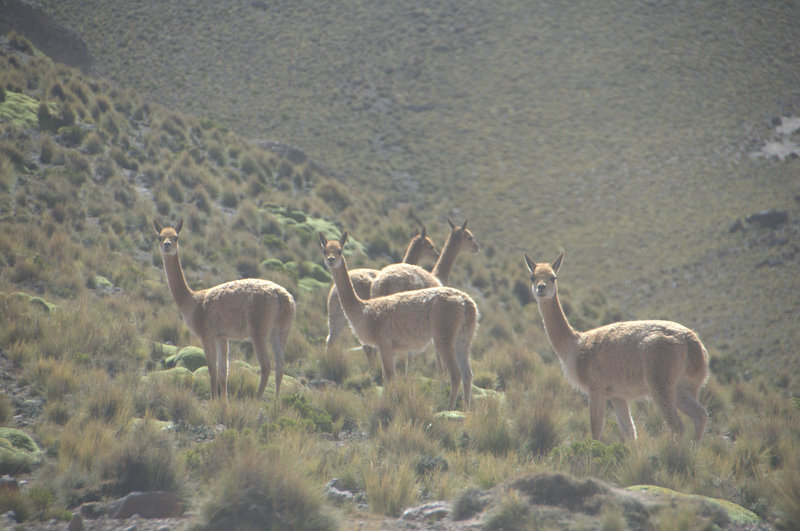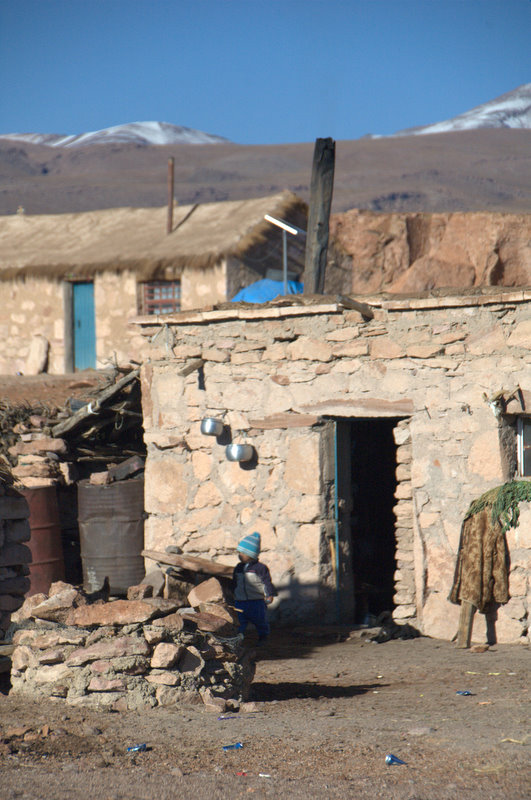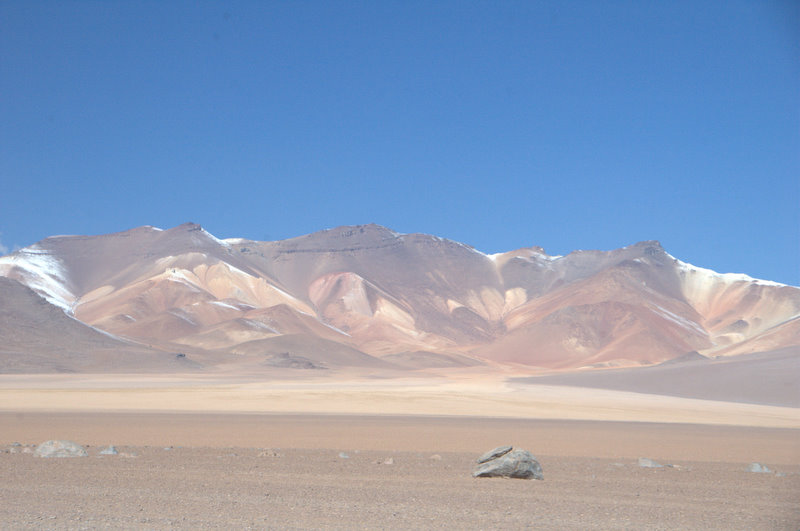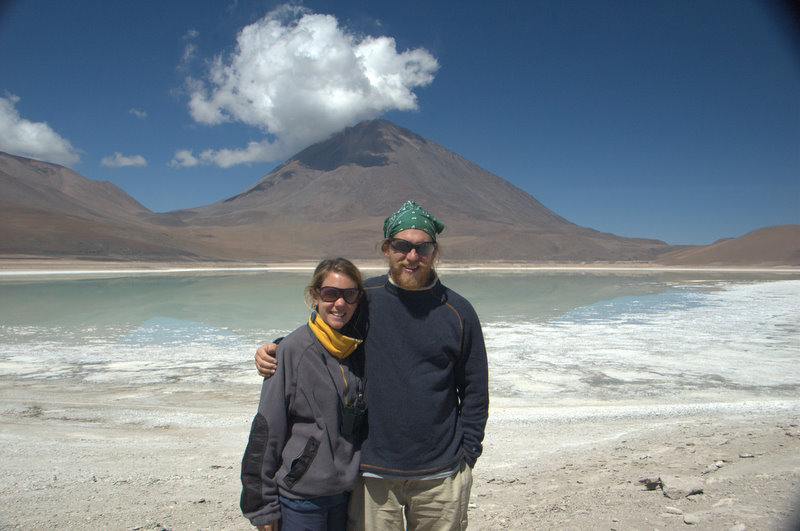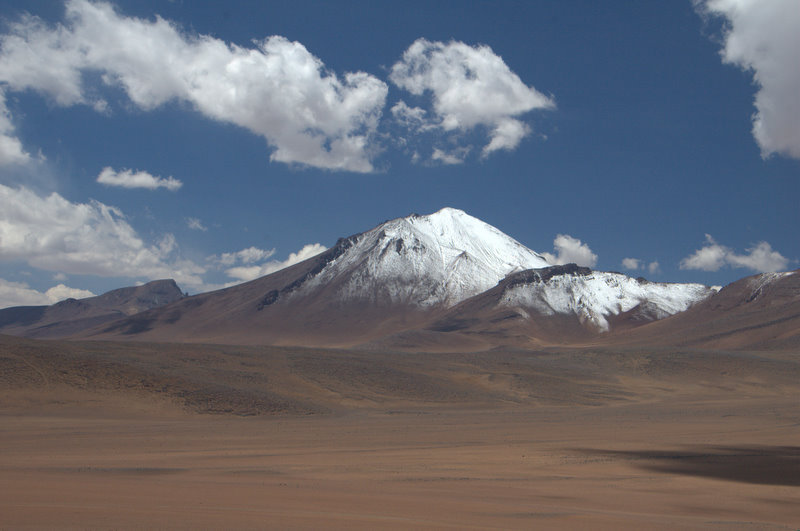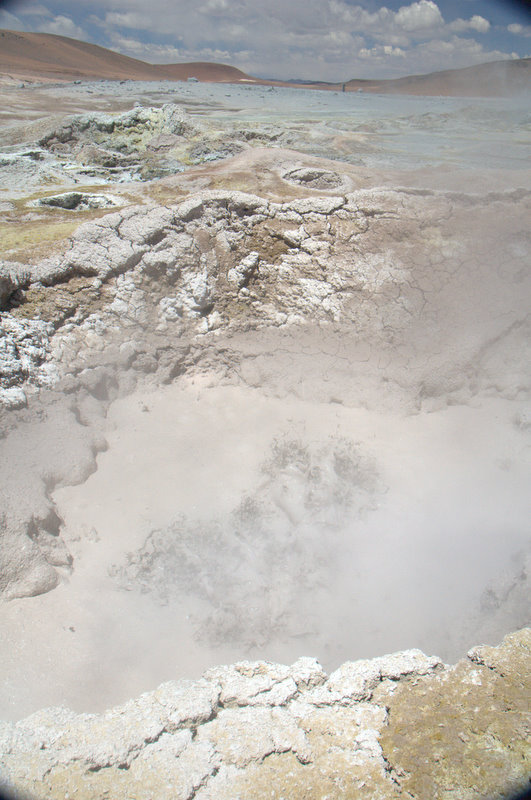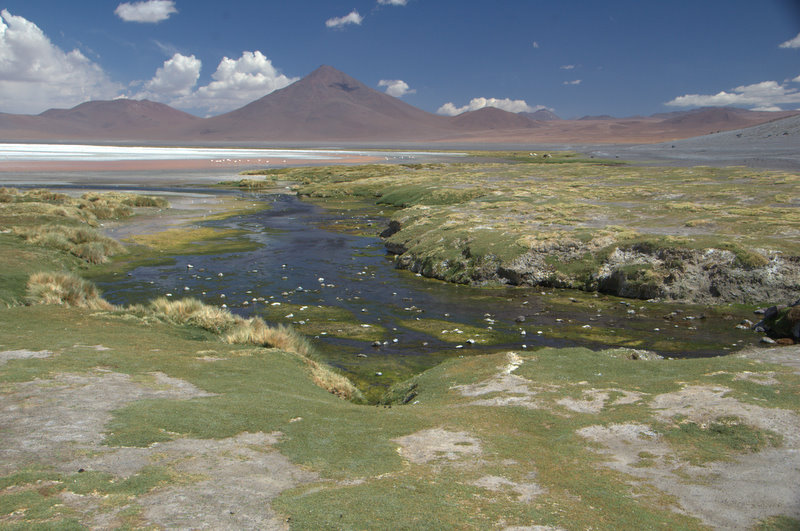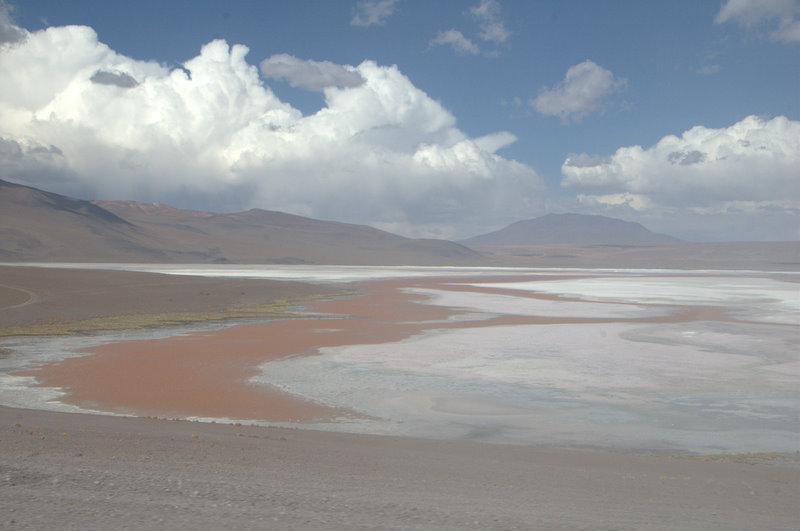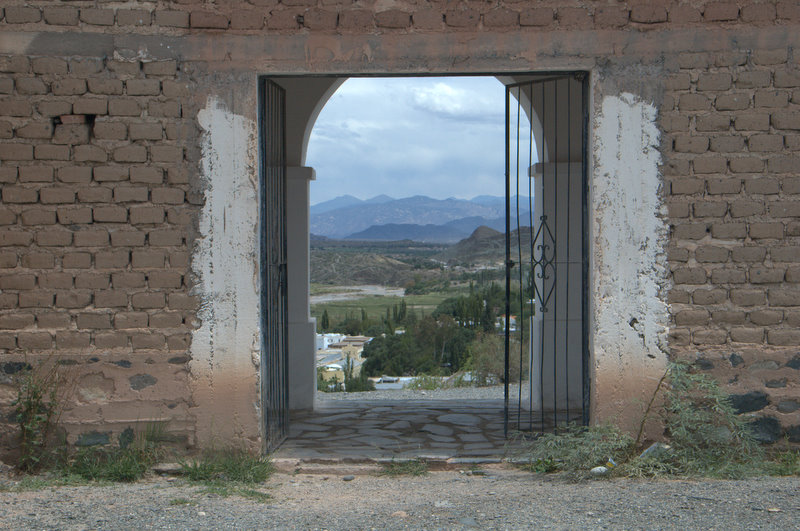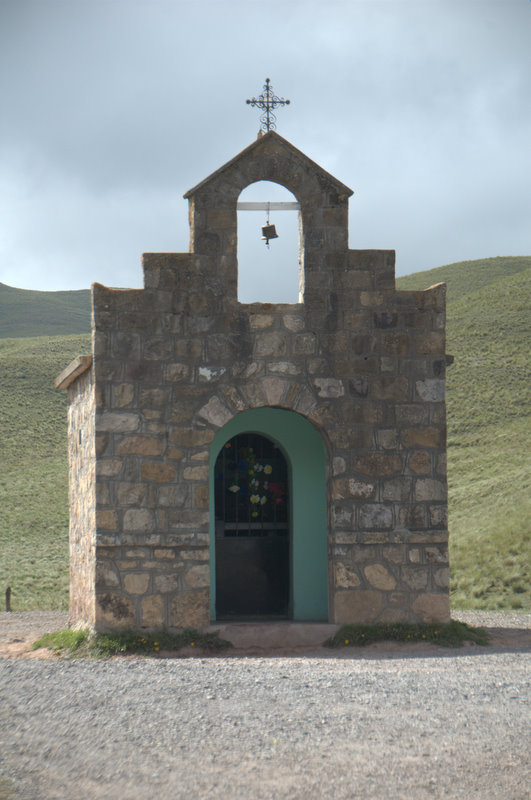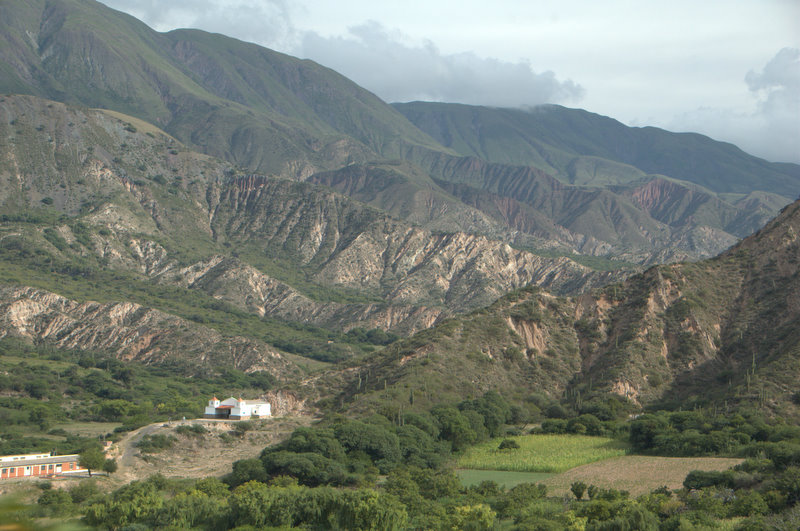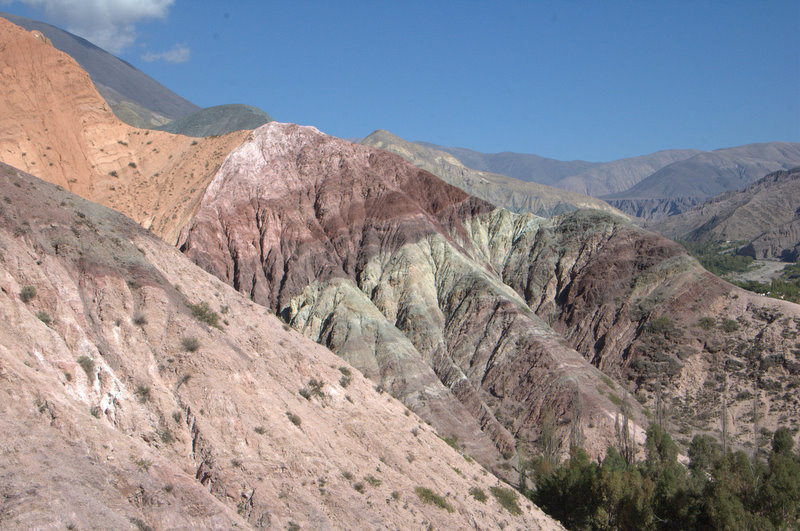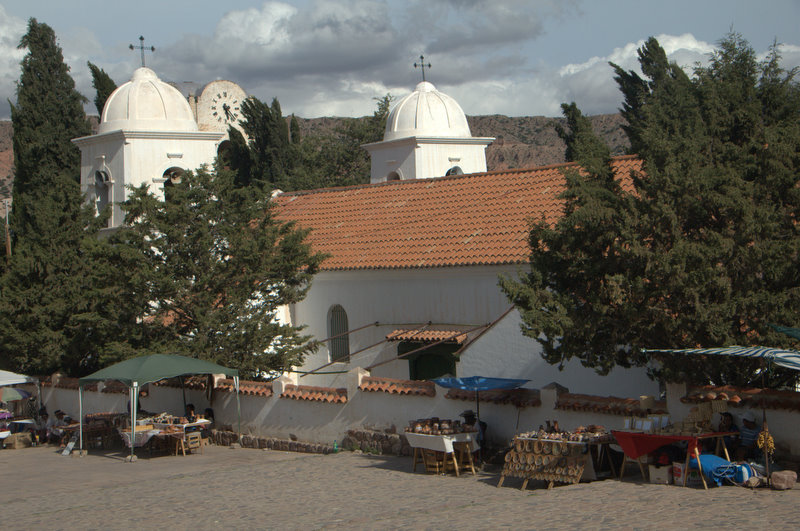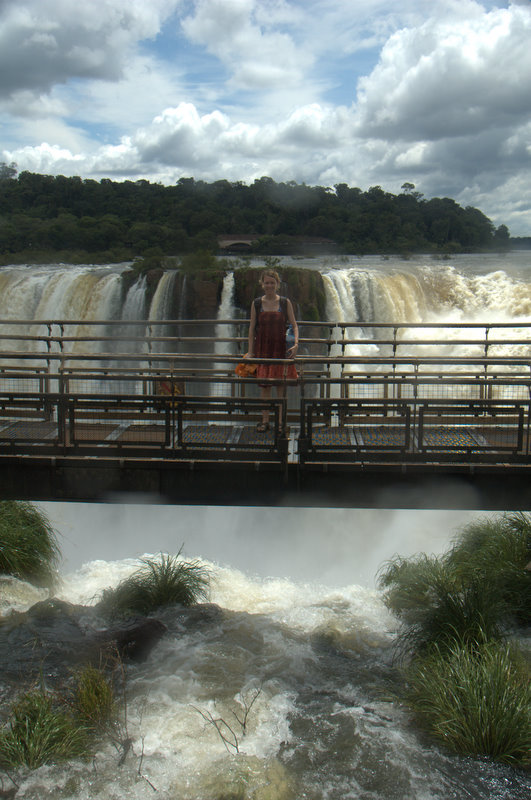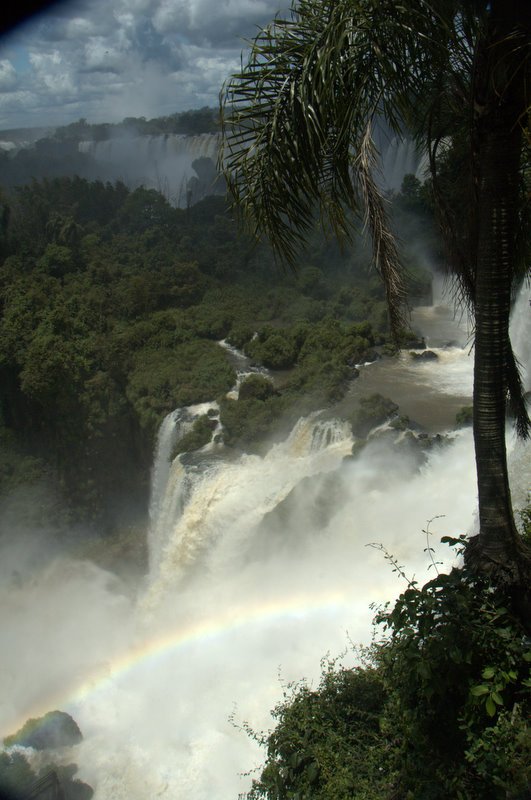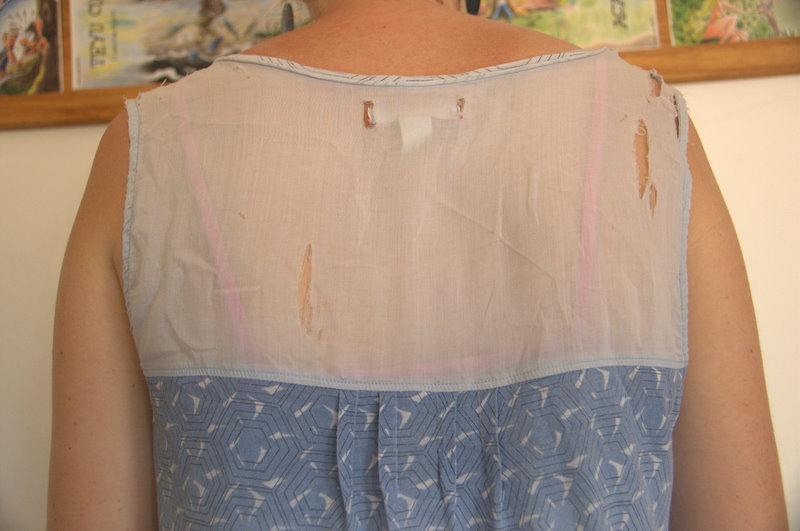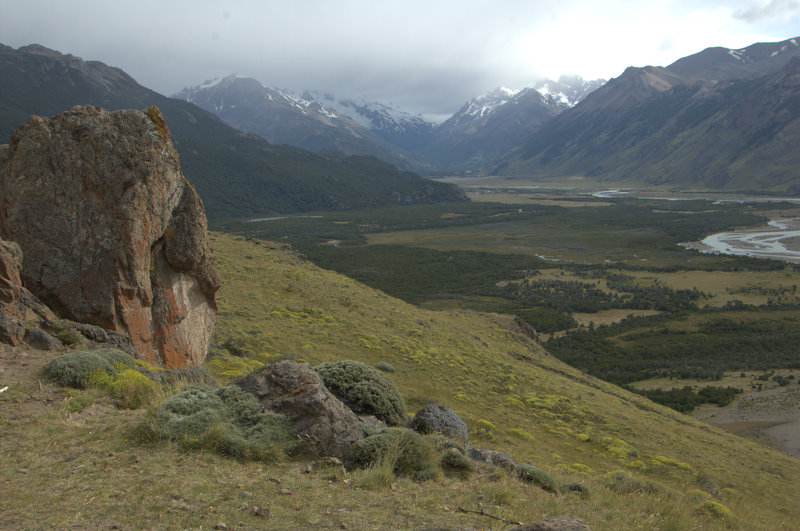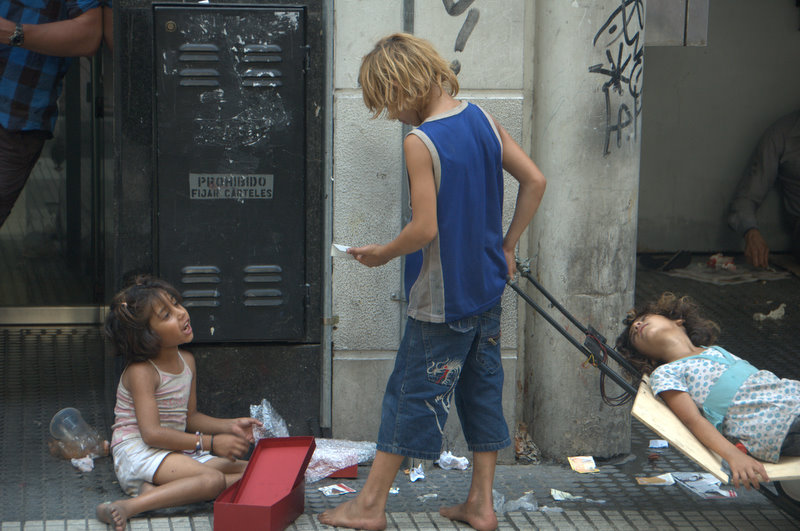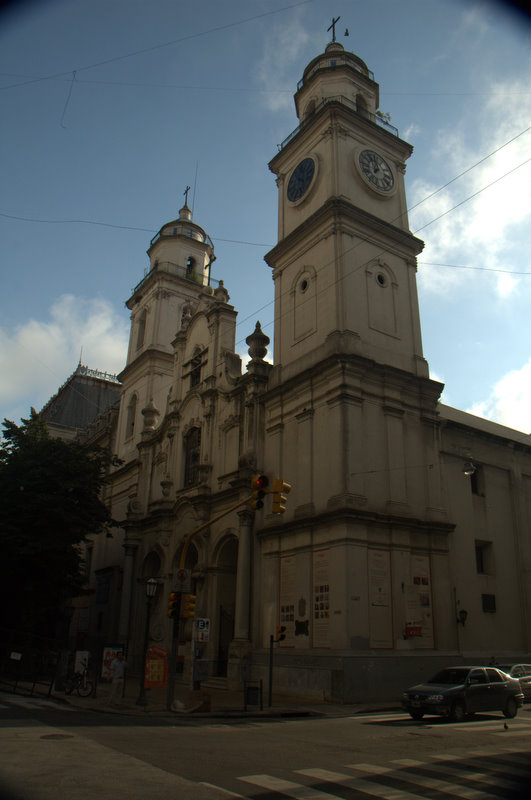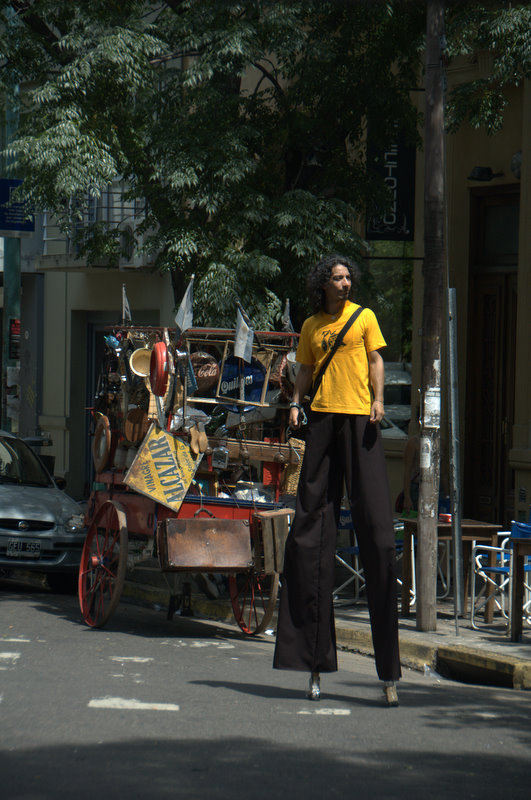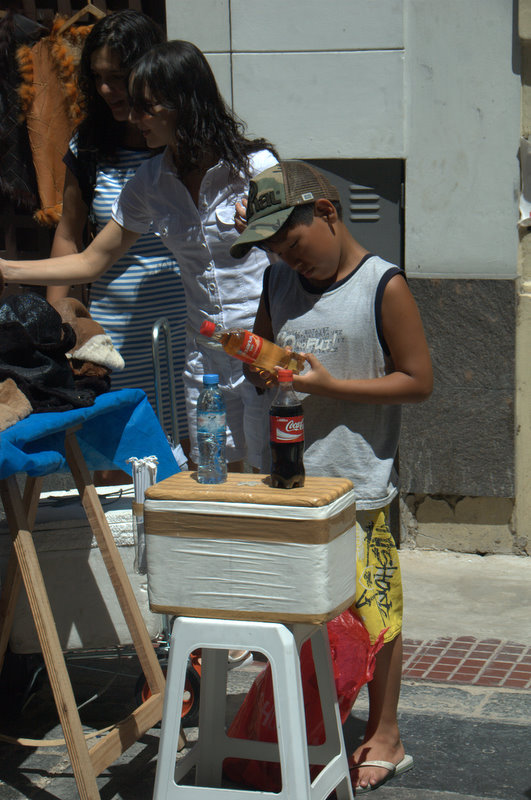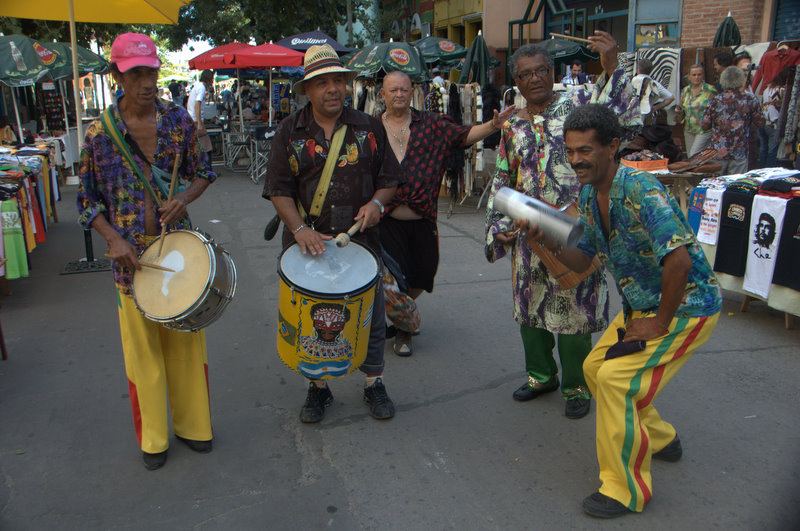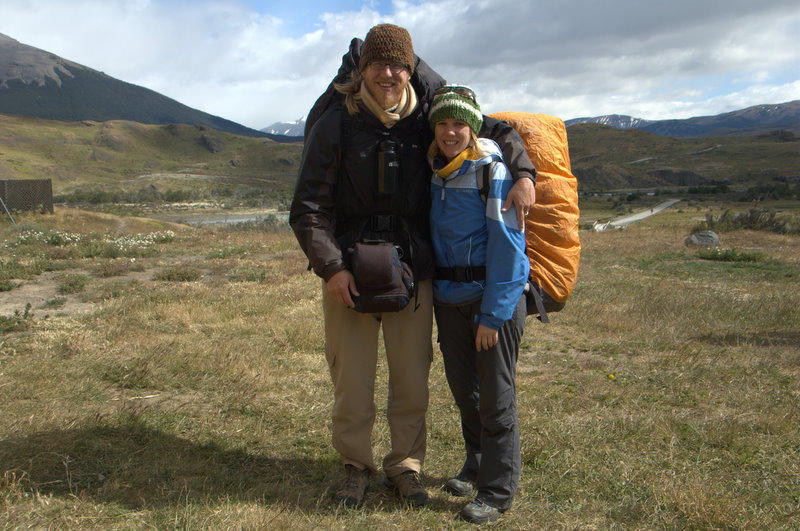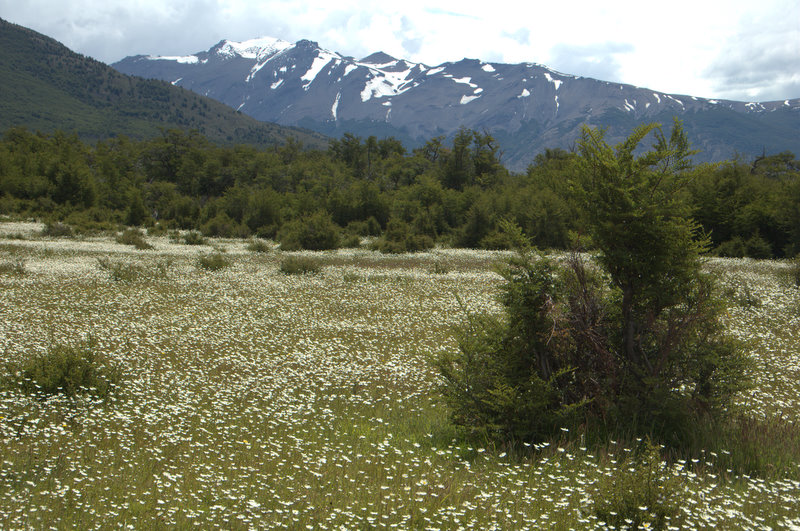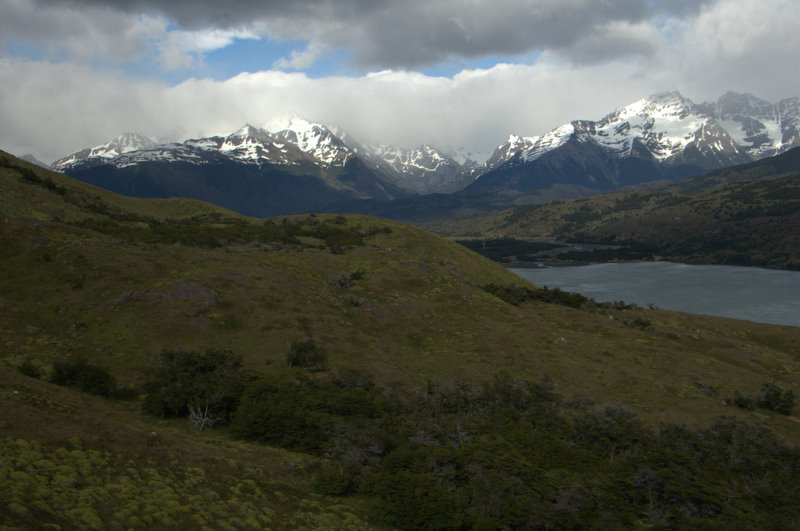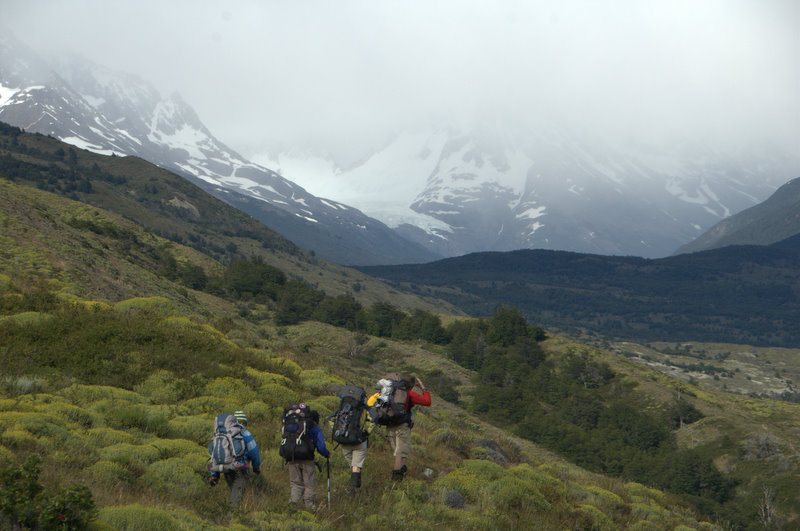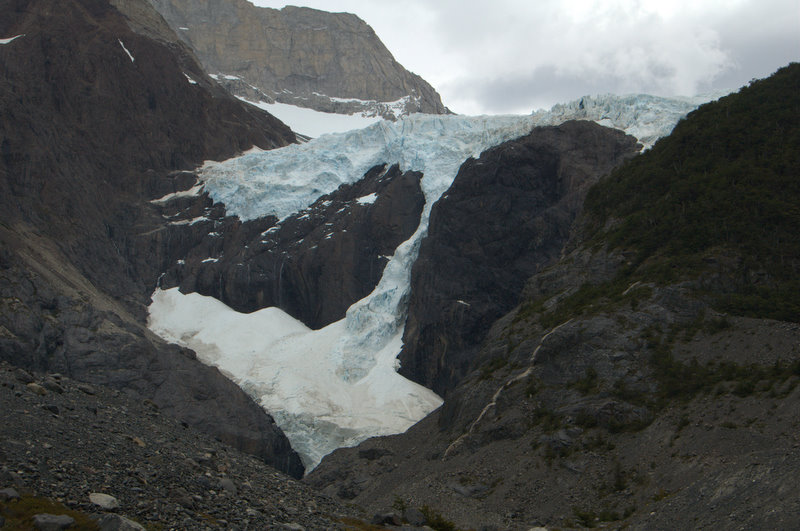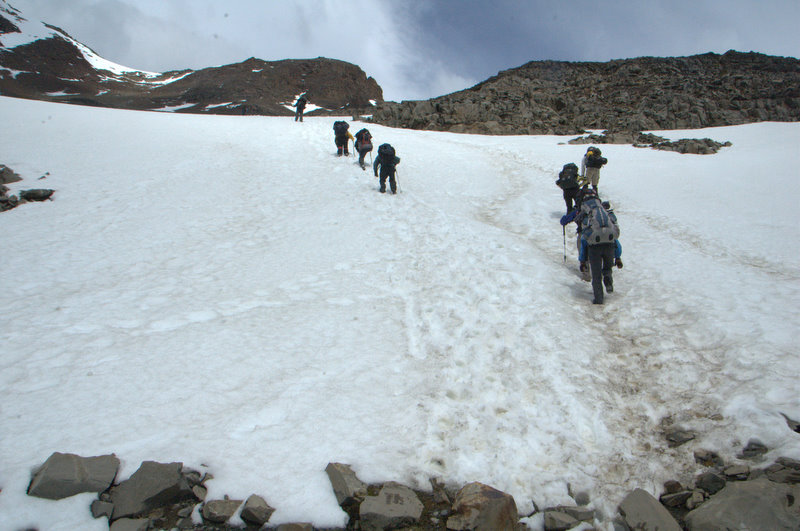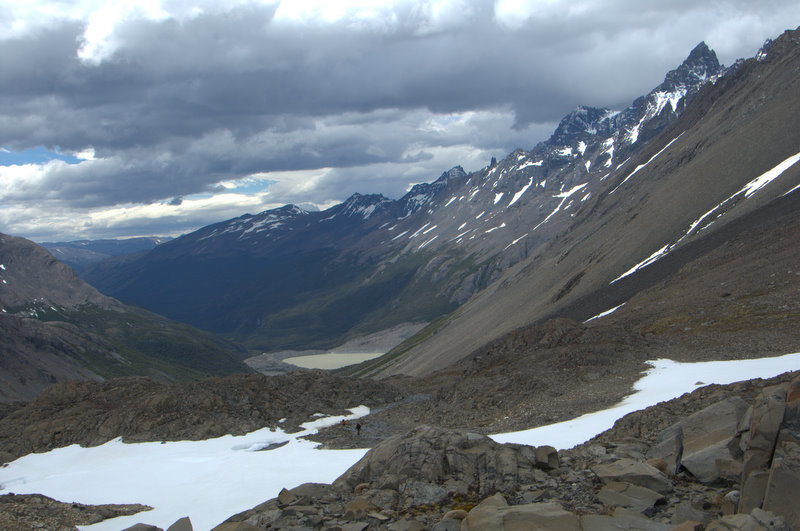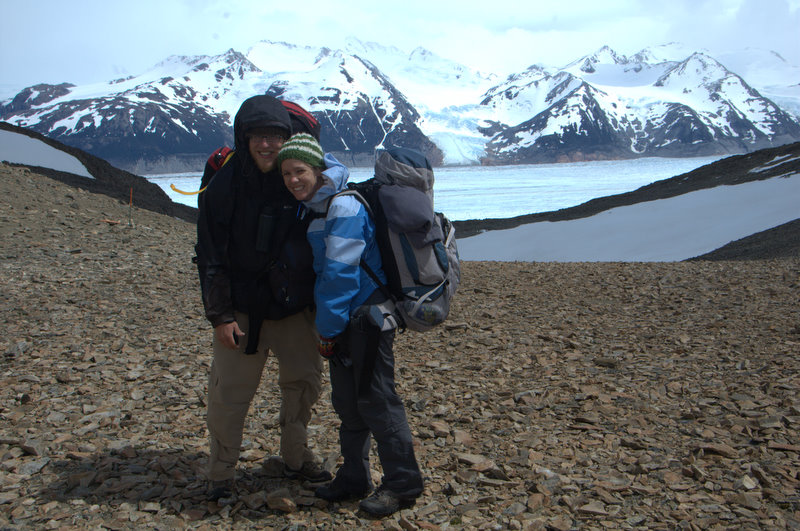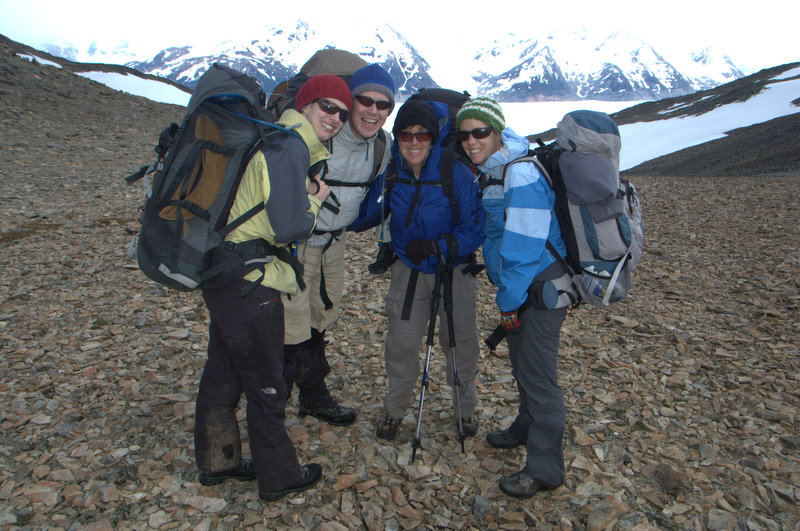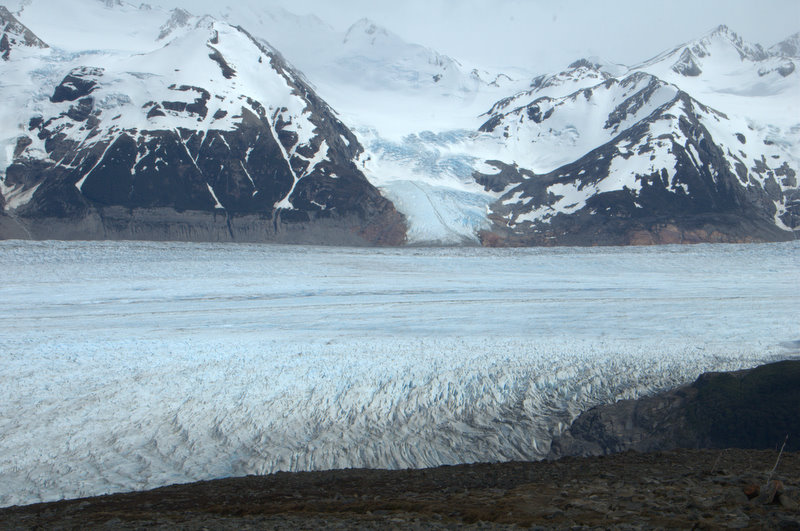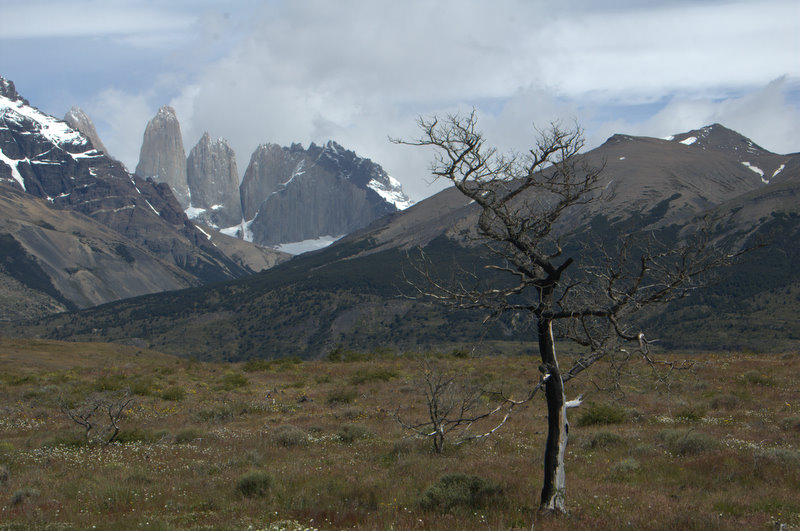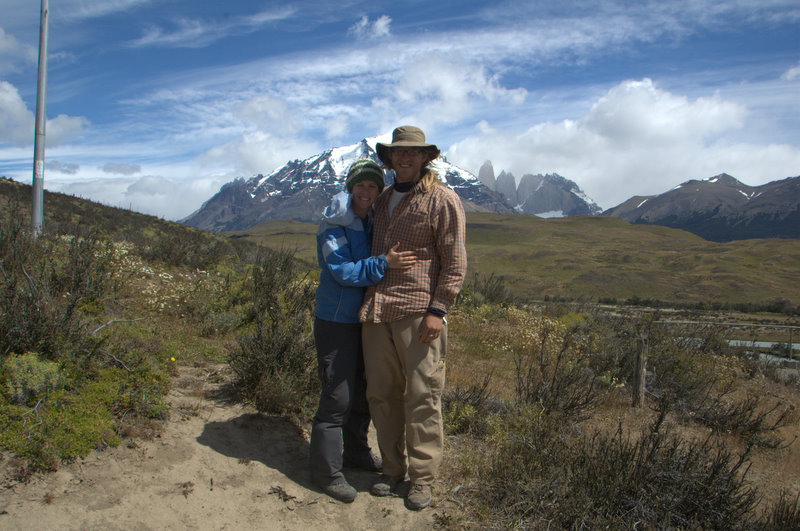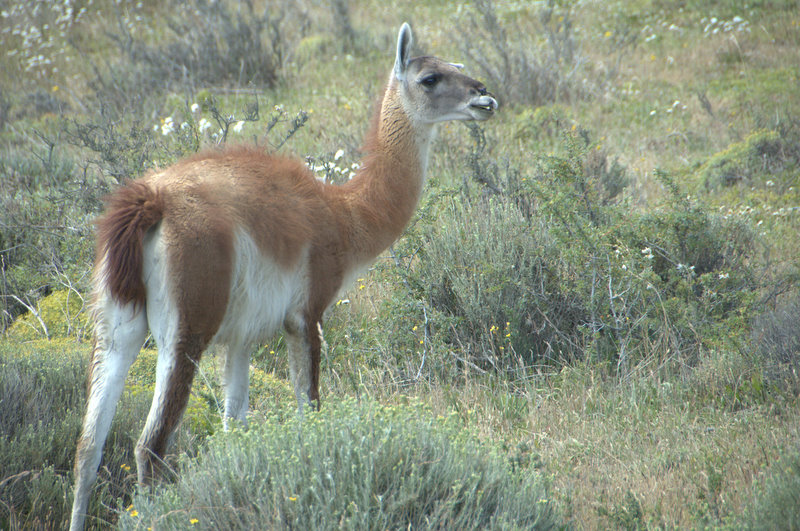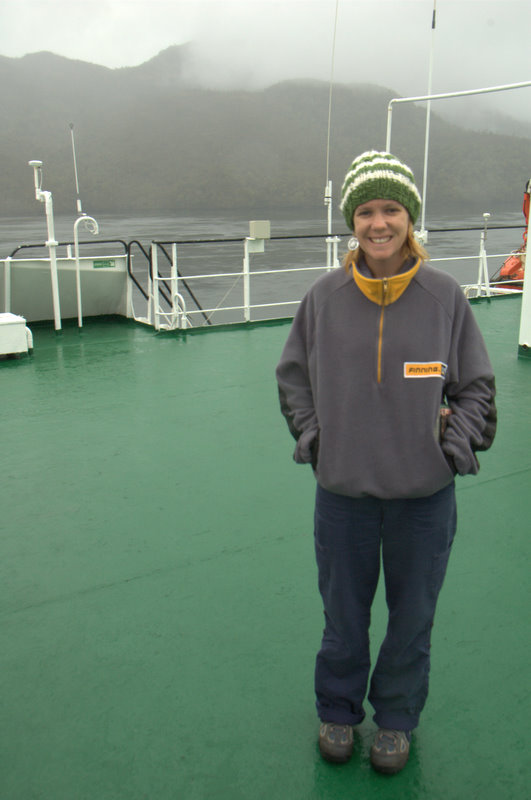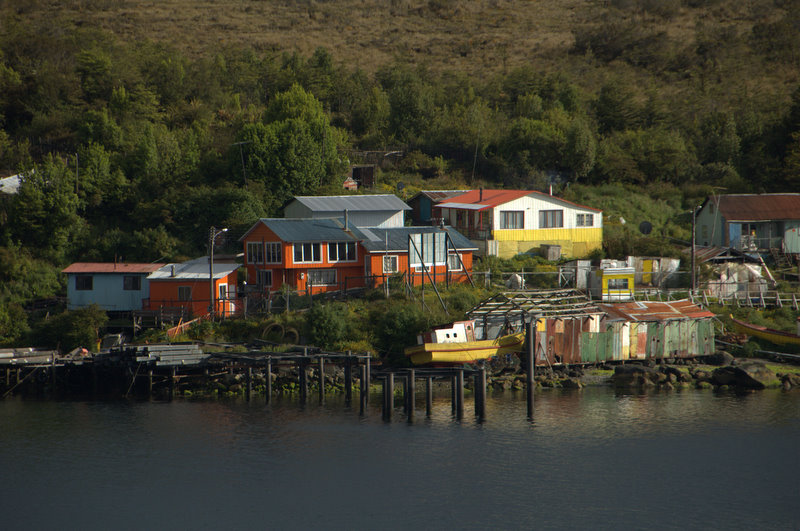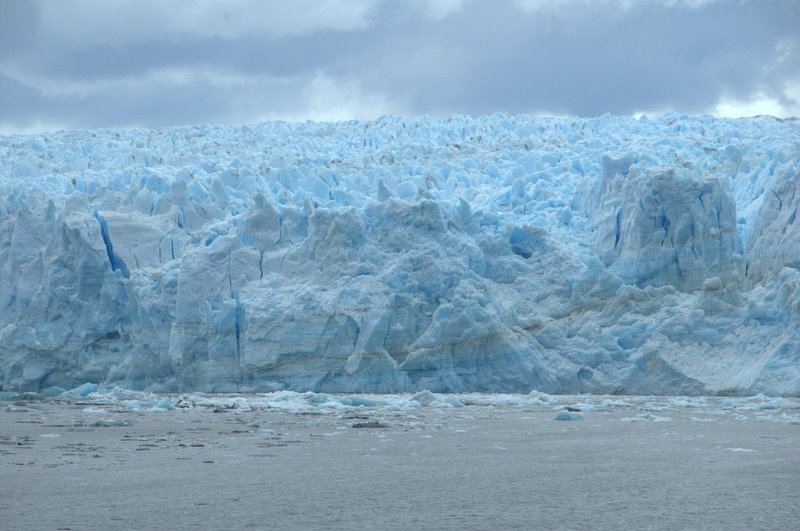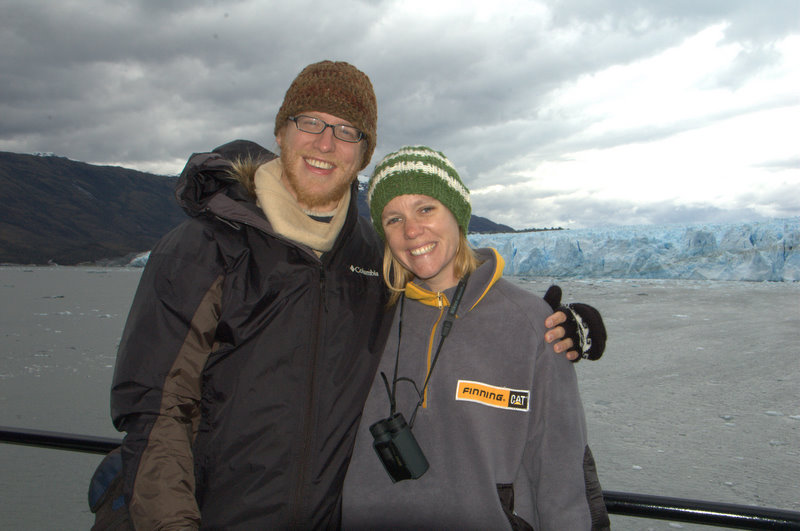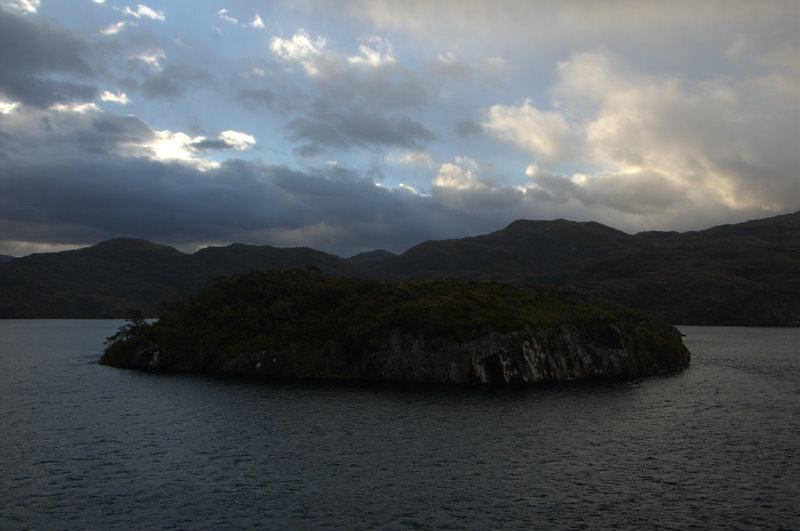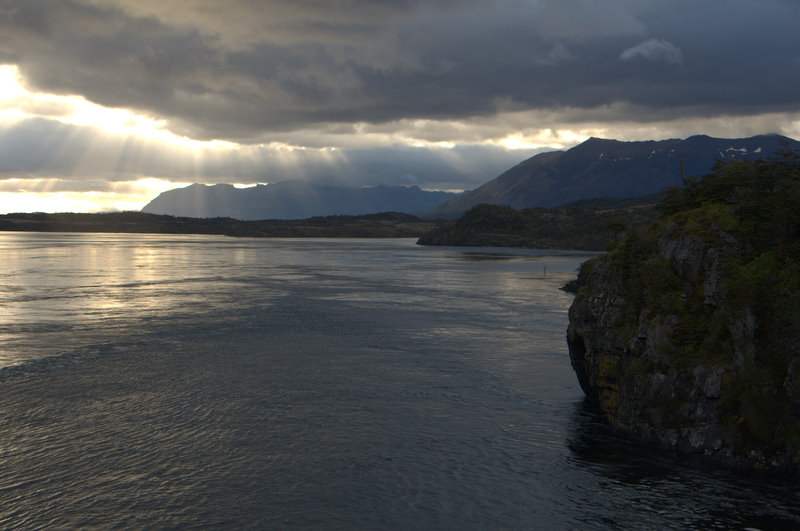March 31, 2010
March 05, 2010
Winding It Down
We are spending our last evening in Lima--in about four hours we will get into a taxi and head out to the airport, for our last flight of the trip, which is back to North Carolina. Our six month trip has come to its end. While I have more to say about our trip, as well as plenty of photos I want to post, let me describe our adventure in Peru (i.e. this isn´t the last entry).
We have had a great time in Peru. Reading the Lonely Planet guide, which has a longer than usual Dangers And Annoyances section for Peru, as well as embassy website, we certainly had our reservations about Peru. We thought that it might be a bit on the less secure side. Yet, we have had no issues in Peru, and have found Peruvians to be considerably more affluent as well as more courteous and friendly than Bolivians. Beyond that, the bus system and roads here have been eons ahead of Bolivia; our night bus from Ariquipa in the south to Lima (which in particular was warned about in the LP) had more security measures than most flights we have gotten onto. For example, they were pretty thorough about searching every passenger, they had GPS monitoring on the bus for the trip, and a security officer came through the bus prior to departure taking every passenger´s photo, which I´m sure is a deterent to those considering a midnight hijacking.
After leaving Puno as early as possible after a single night´s stay (it turns out that our cheap hospedaje became a per-hour hospedaje after midnight, as Jess found out with loud neighbors), we headed up to Cusco, which was nearly ten hours away by bus. Both the trip to Cusco and then back out through the same valley on our way to Ariquipa were very scenic as we crossed over a high mountain pass then dropped in a verdantly green valley filled with adobe villages and farmland. We ended up staying in Cusco for three nights; we found a great hostel where we met several very nice European folks and enjoyed several days´ good company. Cusco itself is a pretty fun city; like La Paz, it is built into a valley, though not as dramatically as La Paz. Its center is very colonial and beautiful, and the hills leading up from the center are lined with narrow little passageways that seem to be straight out of history. Naturally, most people come to Cusco to visit Machu Pichu, but landslides have closed the famous park until probably April; we could have visited other less famous ruins, but we were too cheap to pay for the tours, especially considering they required an additional $25 entrance fee each. We´ve seen enough ruins anyhow on this trip; as my friend Will would describe castle ruins, they ain´t nothing but piles of rocks. Besides, there are enough ruins scattered around Cusco proper that you get the idea, and seeing those piles of rocks are free.
At any rate, we could have definitely spent more time in Cusco, it is the kind of chill town that weeks slip by in before people realize it. It is very easy to do absolutely nothing in Cusco, especially in the afternoons when the clouds gather, and as rain starts to fall, and there are plenty of cafes and coffee shops to relax in. For us, we did a fair amount of walking and exploring, but definitely we could have done more. We spent a fair amount of time with our friends, just enjoying a fun city and good conversations over food and drink. Alas, we had to continue on, so we bought tickets to the town of Ariqipa, which is Peru´s second largest city yet seems more like an overgrown town. The big attraction of Ariquipa is that it is a couple of hours away from two very deep canyons that are billed as being the deepest and the second deepest in the world. One of our days we spent walking around Ariqipa, which is a beautiful city; the other day we took a single day tour out to one of the canyons. After all, it´s not everyday that you are just outside the world´s deepest canyon, and besides, I was curious about the comparison it would have to the Grand Canyon. The tour itself was nice, we stopped in a couple of villages for photos and food, and of course we headed out to the canyon. Actually, honestly, with no bias, I can say that while we did come to a section of the canyon that was very deep, the scenery as a whole wasn´t as impressive as the Grand Canyon. At that park, you can stand on the lip of the canyon all along its length, and you can look straight down 1000 or more feet; that is not to mention the vibrant colors of the Grand Canyon. This Peruvian canyon didn´t have the vibrant colors, though its green walls were beautiful; most places were not that deep, only sections that passed through higher mountains. It was beautiful territory; the valleys were filled with little villages and hills covered in terraces that likely dated back to Incan times. We really did enjoy the tour.
From Ariquipa, we continued on to Lima, in the forementioned night bus. We´ve had quite a good time here. We spent our first two nights in a hostel, which was a very nice hostel considering we paid $5 each per night. Last night, though, we decided that we needed to finish our trip in something a little more luxurious than a 10-bed dorm room, so we found a decently priced hotel (these are surprisingly expensive in Lima), which I´d thought was a 3-star hotel from what I saw online, but was surprised to see was a 4-star hotel. Indeed, it was quite nice, in particular its restaurant, where we rang up quite a bill to celebrate our last night of the trip. But back to our explorations of Lima: our first full day, we explored the Miraflores area of Lima, which is definitely the more affluent area. Prices there were much more expensive, and the area itself felt a lot like any European country or America. There were Starbucks and KFC abounding, very nice cars drove around, and the beachside cliffs had ritzy condos along sidewalks with running paths, complete with ladies in fancy tights jogging. Though we felt a little out of place, being that we are a bit grungy these days, we still enjoyed walking around the area. For lunch we found a little restaurant where we tried the classic Peruvian dish, cerviche, which is raw fish marinated in lime juice; it was wonderful.
Our explorations of central Lima have been a little more of the edgy experience that we definitely prefer. Lima is a massive city (it has over 8.2 million people living in it), and even though our hotel is definitely in the center, it is still a long way from the Plaza de Armas, which in Peru and Bolivia is every city´s center. In Lima, this is the nexus of not only the touristy colonial buildings but apparently a good number of government buildings. We wanted to get into the center, but it was quite a hike, so we instead jumped onto one of the micros (minibuses), which was quite an adventure. First, it´s never really clear where their destination is (they follow circuits) because they don´t seem to have any labeling; also, even if our Spanish was better than it is, we still didn´t know exactly how to describe where we wanted to go, so we just offered money and told them norte (north). Our first trip into the center didn´t go as planned when the micro took a left midway and headed away from the center, but after that trip we understood the system enough to get back to the hotel last evening as well as head back into the center this morning. As I´ve mentioned before, taking the public transport is all part of the immersion process and important for getting a feeling for a city.
Exploring Lima has been quite fun, from taking a tour of the creepy catacombs beneath one of Lima´s oldest cathedrals to strolling through this city´s numerous, well-kept plazas and parks. I even taught a young Peruvian a cuss word in English when I muttered it as our bus made an unexpected stop and bounced my head off the seat in front of me; he repeated it very well. Jess and I understand that this is a huge city with plenty of poor folks; we saw the shantytowns on our way into the city, unpowered shacks out in the bland desert that surrounds this city, whole areas of what they call young cities here, where the quality of life is surely much less than what we´ve seen inside Lima. We have understood that with such poverty in the outskirts, opportunistic crime is an issue. On the other hand, we haven´t felt like Lima deserves a worse reputation than a city such as Phnom Penh in Cambodia, for example. There is an edge here, yes, but that is what we like.
At any rate, we are sad to be bidding this city farewell this evening, for it is the last destination of our trip; therefore we are bidding farewell to our adventure as well. But there are many things from home that we have missed and are looking forward to returning to: our families, our dog, having a routine again, washing machines. We were discussing it this afternoon strolling around in Lima: it´s sad to have our trip come to an end, but there is something about the anticipation of both an upcoming trip as well as the return home that is great. Once you´ve been out for six months, for example, that anticipation fades, and being somewhere great like South America becomes familiar, the background of your life. That is when you know it´s time to head elsewhere, to another country, to your own backyard. That anticipation is quite a great thing.
Until next time, be safe.

February 28, 2010
Photos From Tour Of Salar de Uyuni
Here are some of the pictures I took in the Salar de Uyuni and the surrounding area during our four day tour. Pretty special place, nothing else like it on Earth.
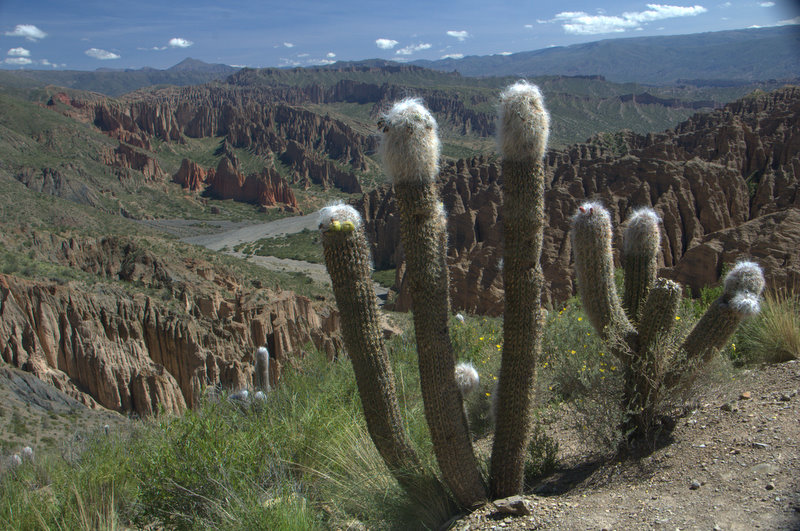 Cactus & Valley, Outside Tupiza
Cactus & Valley, Outside Tupiza
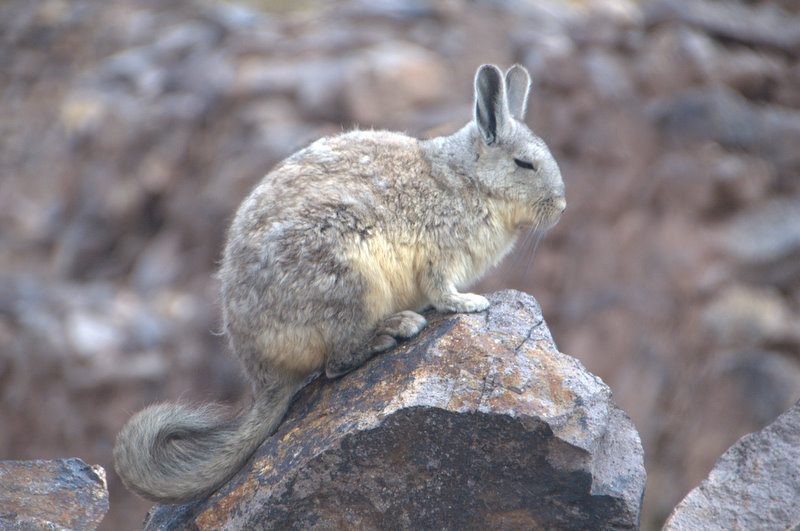 Odd Rodent Common In High Bolivia
Odd Rodent Common In High Bolivia
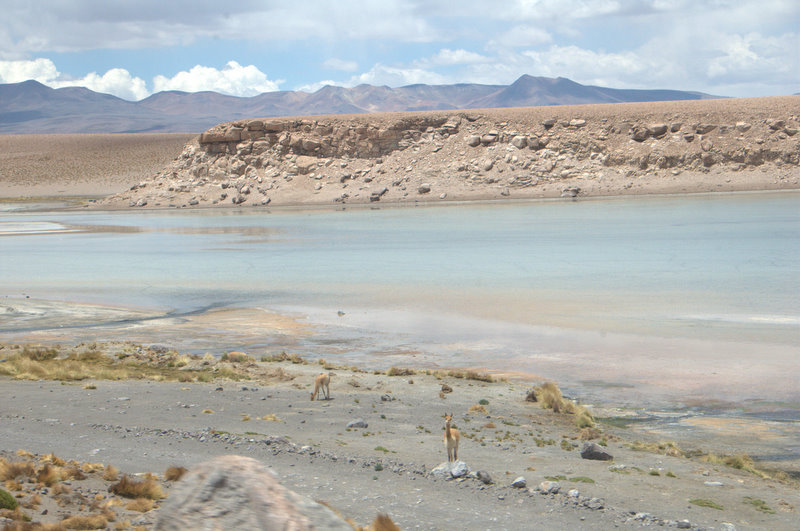 Laguna Verde, Near Chilean Border
Laguna Verde, Near Chilean Border
 Fumaroles Of Hissing Sulfur Gas
Fumaroles Of Hissing Sulfur Gas
 Rocks At Mirador Volcan Ollague
Rocks At Mirador Volcan Ollague
 Rocks & Distant Volcan Ollague
Rocks & Distant Volcan Ollague
 Jess & Aaron, Sunrise, Salar de Uyuni
Jess & Aaron, Sunrise, Salar de Uyuni
 Jess & Aaron, Isla del Pescado
Jess & Aaron, Isla del Pescado
Until next time, be safe.

February 23, 2010
Peru: The Final Country
We have arrived this afternoon in Puno, Peru, a city of about 100K citizens that sits on the western shore of Lake Titicaca. We have reached the final country of our world tour, and now only have about a week and a half of this trip left. One of my common habits is to write out a little calendar of the next couple of weeks on the backside of a piece of paper, as we are pretty much just making this all up as we go. It was incredible this afternoon to make a calendar with three weeks on it, and to see that it won´t be filled up; we´ll be home before the end of the second week.
Let´s go back about a week. As of my last post, we´d landed in the crap town of Uyuni. I don´t want to complain, but I can´t illustrate what Uyuni is like without being negative. Basically, it is a town that exists for two reasons: for the harvest of salt from the nearby Salar, and for tourists who come to join the type of tour that we took out into the Salar. There was little evidence of the salt industry, though I didn´t go looking. As for the tourist industry, it is apparent in the restaurants, tour agencies and accomodation around the town´s center, but what I couldn´t understand was how rude people were to travelers. We had our share of rude people, but apparently it is worse if you are Spanish speaking, because then they can be really rude. We were lucky enough to arrive on the last day of Carnaval; this means that not only did we get to witness the shameless inebriation of the townsfolk, there was also a desperate surge of travelers (especially foreigners who would give a big toe to get out of town) trying to buy one of the limited tickets out of Uyuni. We fought our way into the fray, and managed to get a night bus after wasting a full day and a half in that place.
It was against our judgment to take the night bus, because of rough road conditions, but we did what was necessary to get up to La Paz. Actually, the trip was really quite good, except for maybe the first four hours, which had us on a dirt road heading north out of Uyuni towards Oruro; it was incredibly bumpy, imagine four continuous hours on a washboarded road. Arriving in La Paz was really great, though; I really think that La Paz is one of my favorite cities, and certainly my favorite city in South America. We had made reservations at a hotel, so once we arrived in the very orderly bus station, we made our way down the hill towards the center (La Paz is in a valley, ringed at the top by the slum/suburb El Alto, and everything leads down from there to the center. The view from El Alto is wicked, but we didn´t have any desire to stroll around there, or even get out of the bus). We soon found the hotel, it wasn´t expensive, but it was certainly nicer than any accomodation we´d had for awhile, since we figured we would need a quiet place to rest after the trip to La Paz.
Exploring La Paz was a real joy; it is a truly vibrant city, a mix of traditional and modern, of the classic icon of the ladies in their petticoats and bowler hats, of busy and loud traffic and a witch market selling the fetuses of llamas among other charms and potions. It is a city of stellar views, of steep and cobblestoned streets, of beautiful plazas and churches, and yet a city with an enough of an edge that it keeps you interested. You can´t feel part of a city without taking its public transport, so we boarded a couple of the camiones, which are minivans that follow routes and pick up people along the way. In Kenya, they are matatus, and they have many other names in other countries, but what doesn´t change about them is that riding inside, you certainly feel immersed in the culture. Speaking of which, the city is intoxicating in its culture; the people watchin is superb, we managed to visit at least to the outside of the infamous San Pedro Prison (tours are no longer possible), and wandering through the streets in a vague walking tour that would culminate with ice cream presented endless scenes that seemed right out of the photos of our Lonely Planet, or maybe a National Geographic. (Noted: the locals don´t like having their pictures taken.) Visiting the multiblock outdoor market that sold literally everything one might want was almost overwhelming, while on the other hand La Paz is one massive market; most streets have vendors set up, and some streets are so clogged with stands it is difficult to walk along. For being a Third World Country, there is an amazing amount of stuff you can buy.
Bolivian food isn´t anything to write home about, so we ended up enjoying the multitude of international cuisine present in La Paz (something I found remarkable). We ate at Turkish and Moroccan restaurants, to see how well these styles would be represented in Bolivia. We had the choice of eating sushi, but I don´t think I´d ever be hungry enough to eat sushi in the landlocked and less than sanitary Bolivia. Of course there are the European style restaurants, to cater to the tourist masses. I was still pretty stunned on the variety that we could choose from.
We visited the Coca Museum, which I thought presented the coca plant in a relatively calm manner. This plant, though the source for cocaine, has a pretty remarkable history, and has far greater uses than most people understand. For example, there is a stunning number of medicines that I use as a nurse on a frequent basis that is derived from coca (Novacaine? Bupivicaine?). Most people would not believe how much coca is imported into the US for legal use; I think CocaCola alone imports something like 240 tons annually, as the leaves are used to flavor the drink (cocaine itself is no longer an ingredient). Besides that, coca is heavily engrained in the culture of the people of the Andes, who chew it because it increases oxygenation, suppresses appetite (important for the very poor), and has other properties, none of which are to get high. I can certainly attest that as we wheezed our way up the 45 degree streets of La Paz, I was wishing I was chewing on a big, green, soggy mass of coca leaves.
We stayed three nights in La Paz, and were reluctant to leave. Looking up that last evening at the valley walls, lined with the glittering lights in a way that made it seem like you were flying and looking down at a city, the air clear from the huge rainstorm (including hail) we´d received late in the afternoon, I felt quite at home in the city. Sure, I didn´t feel comfortable walking around with my camera after dark, but then again, I wouldn´t feel so comfortable in NYC in the same situation. At any rate, we were sad to board a bus our last morning and head on for a three hour trip to Copacabana, right on the Peruvian border and the shores of Lake Titicaca.
Peruvians apparently are fond of saying that they received the Titi and Peru got the Caca. Despite the fact that the LP guide describes Copacabana as South America´s Greek island, I´m thinking that Bolivia got a bit of the Caca itself, with this ugly little city. Copacabana is surrounded by swelling green hills, terraced maybe as far back as the Incas, by idyllic farms and the wide open horizon of the massive Lake Titicaca, but somehow all this glory has escaped the townspeople of the Copa. They have strewn trash all over the city in heaps, along the gutters, and covering the mediocre beach; walking out into the countryside, you have to go about a mile or so before the trash along the roads and clogging the streams under the bridges begins to taper off. It was incredible. Also, again we had the misfortune of arriving during their final days of Carnaval, which presented scenes of old ladies falling down in the streets drunk, of men in clown costumes urinating on every corner (and facing into the street), of loud brass bands blasting away at songs they probably played 80 times a day and yet couldn´t stay together on. Everyone was in costume, so the picture opportunities were good, but the noise, the urine, the massive consumption of alcohol (Bolivians, to add to their many woes, drink something called puro, which is rubbing alcohol, 96% strong; they don´t drink for pleasure, only for intoxication and unconsciousness), and the huge inconveniences (shops don´t open, buses are full, even the banks are closed, on Mondays), was just too much. I can say that I hope that we don´t encounter another rural Carnaval celebration on this trip.
Fortunately, we were able to escape and walk out into the countryside, taking a six hour, 20-22 km hike along a rural road. This hike was immensely pleasurable; there were no other tourists, the scenery of hills and farms and lakeshore was terrific, and it all seemed nearly deserted, as apparently most folks were getting fall-down drunk in town. Most Bolivians don´t seem to have much esteem for outsiders (understandable given their sad history), and most of the time they won´t greet you or look you in the face. So we made an effort as we walked to greet everyone that we passed, and to our delight, we received a return greeting from most everybody, and even a couple of enthusiastic and fun conversations with curious old men. The weather was beautiful, and we walked further than we had expected. We were quite tired by the time we stumbled back to our hostel, especially as we were above 3850 meters for the entire hike and had steep climbs to boot, but we were very happy.
Today, we´d planned on visiting the nearby Isla del Sol, a short boat trip away, but we woke up this morning to a heavy rain. Isla del Sol is famous for its Inca ruins, but there are no vehicles on the island, and all of the road are dirt, so even if the weather improved (which it did by noon), trekking on the island would have been a soggy, muddy, miserable experience. So, we checked out of the hostel, bought tickets for Peru, and here we are now.
A good thing, too, because once we had filled in that calendar with our destinations, it became quite clear (given the large distances between them) that our final eleven days of this trip are going to be very, very busy.
Until next time, be safe.

February 18, 2010
Visiting Salar de Uyuni
We just returned from a four day excursion to visit the Salar de Uyuni. It was an incredible trip, one of the best that we have had one our trip so far.
We started from Tupiza, which turned out to be a better town than the hellhole of Villazon, Bolivia. That little town wasn´t much of an introduction to Bolivia; thankfully Tupiza was better or we wouldn´t have much of an opinion of Bolivia. Honestly, though, it is a different kind of experience backpacking here versus a country like Chile or Argentina. It is much more difficult place to travel through; road conditions are subpar, transportation much slower and inconvenient, and everything here seems to take a much longer time. For example, when we found that there was no ATM in Tupiza and none likely in the next destination, Uyuni, we got a cash advance from the bank, but it literally took over two hours and two visits to the bank. Efficiency is an unknown here.
On the other hand, the tour went quite well. We paid more than we would have if we had started in Uyuni, but we got an extra day of touring in, we didn´t have to go to Uyuni first (it doesn´t have much to offer), and there was only another couple in the vehicle with us, which was really great. Even better, we had a cook with us, whereas a lot of tours starting in Uyuni double the driver as the cook, which can lead to some seriously bad food. So, we had a good setup from the beginning, and despite the many horror stories on the internet about tours gone bad, our tour only got better.
We set out in the morning, our bags stacked on the top of our Toyota Land Cruiser, heading out of Tupiza into the cactus covered hills, through the red and orange valleys of eroded stone and steep hillsides that reminded us a lot of Arizona. We climbed well up over 4000 meters, where we remained for the rest of the tour until we dropped back down to 3700m (about 12,000 ft) in Uyuni. Actually, we were up over 5000m (16,500 ft) for quite a bit of the tour; our driver had us chew some coca leaves when we became dizzy and disoriented just getting out of the truck to look at some ruins of a mining town.
In comparison to the route that we would have taken from Uyuni, we started first by heading into the southwest circuit, which had our route travel over absolutely stunning mountain vistas. Vegetation in such a high, dry environment was sparse, and so the hills were vibrant in ochre and orange colors. The weather was very cooperative, we only had a few hours of cloudy weather as we crossed over a pass on the first day. That day we headed south for the border of Chile, crossing over some incredible mountain passes. We stopped in the ghost town of an old mining village dating back to the 1600s. The next day we went nearly as south as the border, visiting some beautiful lagoons of various colors (due to the high mineral contents). We had lunch on the shore of one such lagoon, where we enjoyed the warm waters of a natural hot springs; getting out was tricky, because of both the altitude and how dehydrated the water seemed to make us. That afternoon, we stopped by an area of open fumaroles and boiling mud pools; we were able to walk out among them, to see the furiously boiling mud and hissing steam coming from cones up close. They´d never let you get so close in the States. Then we visited the famous Laguna Colorada before finishing for the day.
The third day was spent visiting various lagoons with lots of flamingos and other birdlife. That day we also saw a lot of rock formations, created by erosion. Our first stop of the day was to visit the much photographed Arbol de Piedra (Rock Tree), which was among many other great formations. We had lunch at the Mirador Volcan Ollague, which is the lookout of the Ollague Volcano, which is semi-active. The mirador is set among an area of amazing gullies and sheets of rock that have been carved into many shapes by the elements. We spent a lot of time driving through this area, eventually arriving into the Salar Chiguana, which is a salt plain that isn´t as famous or as extensive as the Salar de Uyuni; it was still impressive, driving on the flat, white surface. That night we stayed in an excellent salt hotel, a structure that had walls made entirely of salt blocks, a beautiful building.
Our final day started at 5 am, as we set out to cross the Salar de Uyuni. We headed straight across the flats, a massive area of more than 1200 square meters. We were able to get to a little island called Isla de Pescado, which was covered with beautiful cacti, for the sunrise. We spent the morning driving along on the salt flat, which became brilliantly white as the sunlight became more bright. We stopped to take pictures, using the optical illusions of the endless white horizon, before heading to Uyuni to conclude our tour.
It was really a great trip, one of our favorites. We had heaps of great food, the driver and the cook were terrific, and the other couple, from Holland were very fun to talk with and play numerous games of Rummy500 with. The hostels that we stayed in were very, very basic, but that was certainly part of the adventure, and wasn´t nearly the nightmare that many stories online would have us believe. Of course, the landscapes were spectacular, I´ve never been to such a place. It was worth the trouble entering Bolivia, as well as the money we spent on the visas. It was certainly worth every penny.
Until next time, be safe.

February 17, 2010
Pictures From North Argentina
February 12, 2010
North Argentina Into Bolivia
Though we have finally (and reluctantly) crossed into Bolivia, for the past week we have been wandering around northern Argentina and loving it. This part of Argentina has been quite spectacular, and we found ourselves amazed at the variety of landscapes and environments that Argentina puts up. We´ve gone from the deep south Patagonia to the most northern parts, up to the border crossing of La Quiaza, which is over 5000 km away from Ushuaia in the south.
We ended up in Salta after leaving from Puerto Iguazu. Being that Argentina is an enormous country (8th in the world, I think), Argentinians have really developed a wonderful bus system that is known for its comfort. We didn't get a good representation of that on our 23 hour bus ride to Salta; the crew was surly and unpleasant, there were no movies shown, the food most likely led to a week of GI upsets, and during the night, something happened to the toilet, so the bus soon smelled strongly of urine. We weren't so impressed with the trip. Salta, though, was quite interesting. It is a pretty big city, but the hostel that we stayed in became a refuge, as we were quite exhausted from our trip. The people there were incredibly nice, which was very welcome. We explored Salta itself, checking out its colonial style center, its many parks, and even a museum. Usually we avoid those, as they suck the fun out of a good day, but this one had Incan mummies found on nearby peaks. Only one was on display, but it was incredible to see how well preserved it was, especially considering that it was a natural mummification (the body was found over 6000 meters, or 19,000 feet).
From there we stuck to little villages. Our first destination was the little town of Cachi. It was a very peaceful place of whitewashed buildings and cobblestoned streets. The bus ride there took us through an amazing valley west of Salta, a four hour trip that started in a deciduous forests and ended in alpine desert, with towering snowcapped mountains behind Cachi. En route we were treated to huge views across the valley, which made Jess nervous, as well as the lonely, sparse land that is known here as the Altiplano, the high desert. We stayed a night, which was great, because once the tour buses from Salta headed back, we had the village to ourselves, and strolled around town, dining on Argentinian steak that was even better than what we'd had in BA. The next day we headed back towards Salta, arriving late enough that we stayed another night before continuing north up to another village called Purmamarca.
This little village was quite amazing. It is surrounded by heavily eroded hills that reveal all sorts of colors of soil and stone. There is a hike there that circles through a valley of red hillsides, riven with gullies; the sun makes the red seem almost painted on. Above the village itself is a large hill known as Cerro de los Siete Colores (Seven Coloured Mountain), which truly does have seven shades of color in its soil. The town itself is quite scenic, lots of adobe buildings that make cities like Santa Fe, AZ, look like Dollywood. We'd noticed Argentinian backpackers starting in Salta, but here there were hordes of them, young Argentinos who put a lot of effort into looking a little grubby with tents strapped to their backpacks and dreadullets (mullets made into dreads--horrible). They are apparently on holidays, for the northern highlands are crawling with them.
Our next destination was the slightly larger town of Humahuaca, which wasn't terribly impressive. There was the required plaza, the dusty streets and adobe buildings, but what we enjoyed best was the hostel we found. It had a great view looking out over the town and on to the mountains beyond. It was a very cozy little place. Beyond that, Humahuaca sits in a nice location in the Quebrada de Humahuaca, which is a scenic valley of high hills, deep colors like red and orange, and cardón cacti standing like sentinels; these huge cacti closely resemble saquero cactus in Arizona. From Humahuaca we made a little side trip up to a village that rests in another time, perhaps another world, called Iruya. We had to struggle through the hordes of Argentinian backpackers, and to our horror, there ended up being three buses leaving at the same time to the town, which resulted in us getting onto a different bus than our bags. That made for an uncomfortable ride to the town; a real pity, because this was another amazing trip. The unpaved road went over a 4000m pass before dropping down into a deep valley. The single lane dirt road carved its way down steep hillsides, turning back and forth, and of course we were in a rickety old bus, our bags strapped to the top. It was a great ride, and our bags were just fine. The central part of the village was fairly modern, though steeply placed along a hill; further away, the painted plaster disappeared and the adobe buildings and locals in garb that has changed little since the Incan times became the norm. It was a really nice place, and we hiked all around the village; another village, this one even more remote and less advanced, lay up the valley a couple of hours, but as our time is running short now, we couldn't stay another night. The next day, we left the village and returned to the comparatively urban Humahuaca, where we found a bus heading north to the border town of La Quiaca (elevation 11,358.6 feet). There we spent a night before attempting to cross the border into Bolivia, a process I'd imagined would be quite simple, based on other experiences crossing borders in South America. I was wrong about that.
Though we are just three hours up the road from the border, it wasn't until about 9 last night when we arrived in Tupiza, Bolivia. Getting here was a very difficult ordeal, a truly epic traveling day, and certainly one of the most difficult border crossings we have had yet. La Quiaca was a nice enough little town, and we had a leisurely breakfast, expecting a quick crossing. The day just didn't go very easily, though. To start, we needed a fair amount of cash for our Bolivian visas, so after checking out of our hospedaje, we went to the ATM. There was a line there and it took an hour to get money (apparently there were loads of illiterate people who couldn't use the ATM). Anyhow, we took a taxi to the border, where we stood in line in the sun to get stamped out of Argentina for 2.5 hours. Finally we managed to get across the bridge to Bolivia, where another line lasted a half hour before we were told they didn´t have the visas, we would have return to the consulate on the AR side to get them. So back across the border we went, paid the $135 each for visas, then back to the Bolivian place, where I just pushed my way to the front and avoided that huge line. Once we were officially cleared for Bolivia, we went into the town, to find that the only ATM in town was broken, and the is no ATM in our next destination (Tupiza). So back across the border I went again, to the ATM we were at earlier. Fortunately there wasn't a line this time, and I got out enough cash for awhile. I crossed back into Bolivia and found a money changer, and got Bolivian pesos. We paid for the bus and found a restaurant (we hadn't eaten since breakfast at 8, and it was now 5 pm, Bolivian time, which is an hour behind Argentina). Our bus was late leaving, and the only road leading from the border town of Villazon, which is a major border crossing with Argentina, was this bumpy, hilly, dusty dirt road, probably worse than the road that led out of Mombasa, Kenya, when we were there, which up to this point was what I considered to be one to the worst highways I've encountered. There wasn't anything dangerous about the road, it was only that my butt became quite sore after a couple hours of the bus slowly thumping its way though the potholes and washboards. We were quite happy to arrive in Tupiza, and fortunately, we found an HI hostel next to the bus station; finally the day came to an end.
Anyhow, Tupiza is much more relaxing; we are spending a couple of nights here since we haven't stayed in the same beds for more than a night since Salta. The plan had been to head north to Uyuni, to visit the salt flats, the Salar de Uyuni, which is supposed to be spectacular. However, it turns out we can just leave from Tupiza for a four-day tour. We will still end up in Uyuni in the end, where we will take a bus north towards La Paz; whether we stop along the way is undetermined. We have to be economical at this point with our time; we leave for the US in three weeks from today.
Until next time, be safe.

February 03, 2010
Photos Of Iguazu Falls
Capturing a place like Iguazu Falls on film is nearly impossible, and any sort of verbal description is simply cliche. I´d like to hope that everyone will one day have a chance to see this place, but here are a few shots that maybe captured a bit of the magic of Iguazu for those who won´t be so lucky.
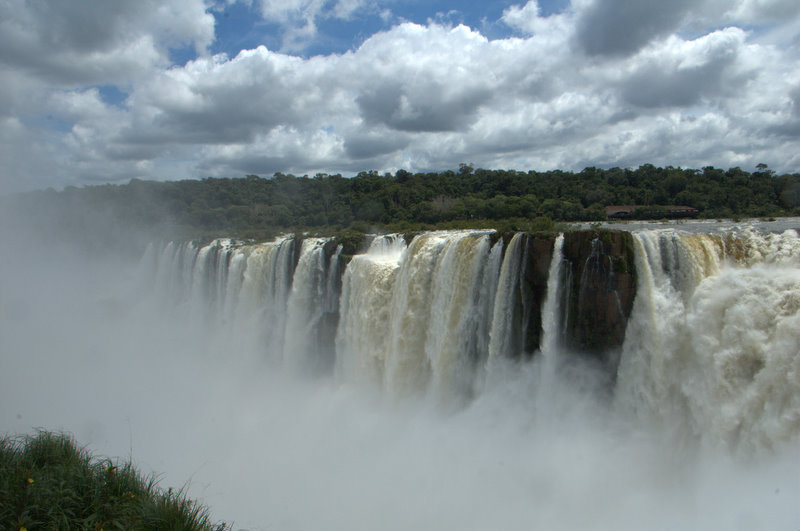 Looking Into Garganta del Diablo
Looking Into Garganta del Diablo
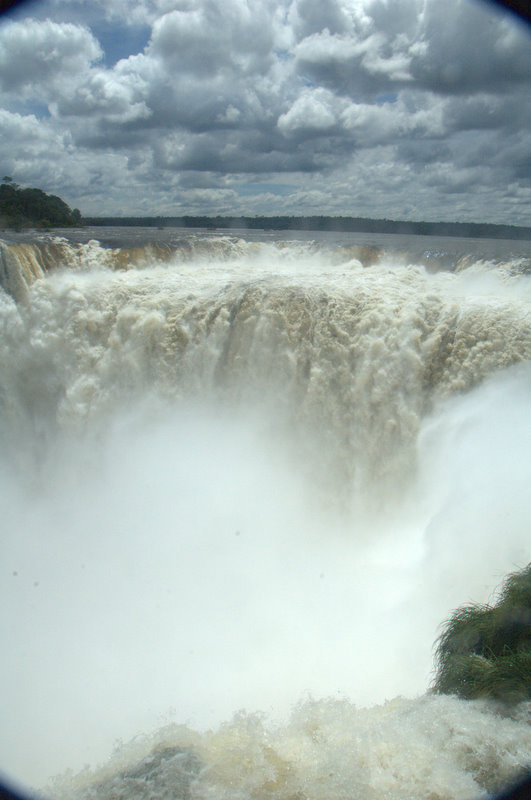 The Maw Of Garganta del Diablo
The Maw Of Garganta del Diablo
 Looking At Falls, Superior Circuit
Looking At Falls, Superior Circuit
 More Water Than You Can Imagine
More Water Than You Can Imagine
 Series Of Falls, From Superior Circuit
Series Of Falls, From Superior Circuit
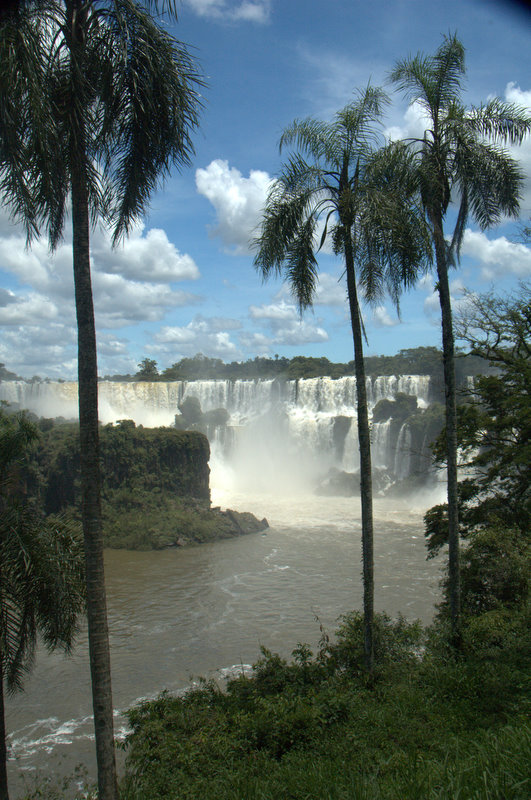 Palm Trees Along Superior Circuit
Palm Trees Along Superior Circuit
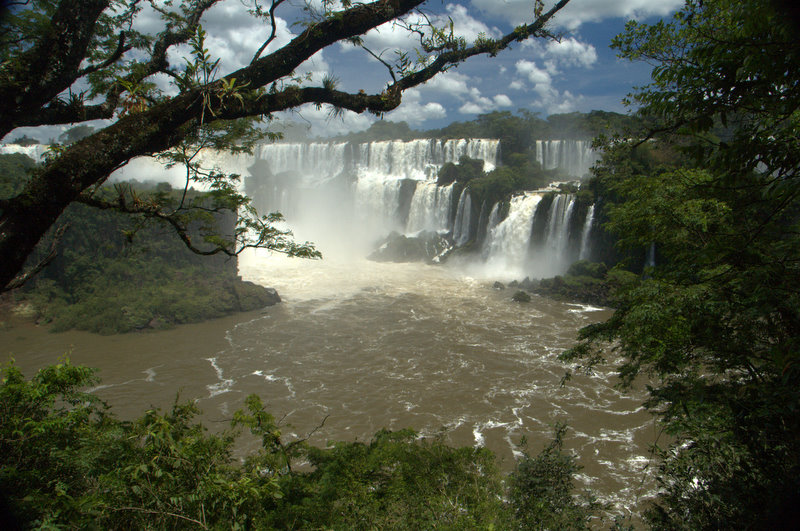 Some Of Falls From Lower Circuit
Some Of Falls From Lower Circuit
 Another Shot From Lower Circuit
Another Shot From Lower Circuit
Until next time, be safe.

Photos From Carnaval In Corrientes
February 01, 2010
A Shirt Falls
Today, we mourn the loss of a faithful comrade on this journey of ours. Despite, and likely because of, five months of frequent use, a shirt of Jess´s has become a casualty of its own light material, which made it comfortable, and its versatility. This shirt has reached a point that regardless of the fact that most probably already view Jess and I as hobos, it cannot continue to be a part of our wardrobe.
It leaves behind three other shirts, two pairs of underwear, and two pairs of pants, a clothing list that mirrors that of Aaron. It is the first article of clothing to succumb to the rigors of the trip, though one of Aaron´s pairs of skivvies was stolen in Europe, and an ill-fitting Northface shirt was replaced by a BeerLao shirt purchased in Bangkok, which despite its poor quality has stood up remarkably well.
R.I.P, noble shirt.
Until next time, be safe.

Uruguay & Carnaval
Since Jess has written about our experiences in Iguazu Falls, I guess that I need to get caught up and write about the week in between the Falls and being in Buenos Aires.
From Buenos Aires, we did indeed head over to Colonia, Uruguay, on a ferry ride across the huge Rio de la Plata, that took about an hour. Arriving in Colonia, we expected to quickly find a hostel, since it is a relatively small town and there are several hostels. To our dismay, it wasn´t so easy to find a hostel with beds, and we had to stagger around the town in this wicked heat and humidity. Apparently, the more north that you go in Argentina, towards Brazil, the hotter and more humid it becomes; that is the marvel of Argentina, that you can go from the subartic weather of Patagonia to the subtropical forests along the Paraguayan and Brazilian borders, with plenty of various landscapes in between.
At any rate, we eventually found a hostel, and we set out to explore Colonia. Uruguay doesn´t get much news; it seems few people seem to have even heard of it, but the country is quite pleasant. There is a lot of history there, being that the country was right between the colonies of Spain and Portugal with all of their colonial interests. Today the place seems is advanced and well off, at least in comparison to nearby countries like Peru and Bolivia. Colonia itself is a quaint town, filled with historic buildings, sycamore lined streets, and cobblestoned alleys that probably date back to the 1600s. There is a nice riverwalk, where we watched the sunset over the Rio de la Plata. Back at the hostel, we had a long chat with a Dutch couple. They were the ones who suggested the next day, as we stood in the Montevideo bus station, that instead of taking a night bus to Salto, which would have had us in the town at 6 am, we should take a immediate bus to Mercedes, which is also on the border of Argentina. Of course, that had us going back east almost into Colonia, but at least we found ourselves in a nice hotel in Mercedes, relaxing in this pleasant town for the evening, instead of taking a long bus ride.
We really struggled with our travel plans in Uruguay, for some reason, starting with our three hour bus ride to Montevideo. We should have gone directly to Mercedes, where we could have crossed over into Argentina, but that didn´t really occur to us until we were already in Montevideo. That meant getting into Mercedes too late to get much further, and also finding that the border crossing near Mercedes was closed, a fact that we could have used before traveling there. That had us going north to the town of Paysandu, to cross over into Colon, Argentina, where we found a night bus leaving for Corrientes. That day involved a lot of waiting, as well as long bus rides; perhaps a bit of planning and further information would have spared some of the time involved. We do like traveling in a flexible fashion, where we make up our plans as we go, but sometimes we end up having unnecessarily long travel days and delays.
At any rate, we were quite happy to be in Corrientes by 8 the next morning. This city is certainly not touristy, there isn´t some impressive natural formation or phenomenon to attract foreignors, so we felt that we were getting a real taste of Argentina. Of course, Corrientes is also an industrial town, so it has a bit of an edgy feel to it; we still liked the city quite a lot. We found a hostel there that could be one of the most beautiful hostels we have encountered on this trip, in a restored house that had once been the residence of some members of the city´s upper crust. We had to sleep half the day to recover from two full days of bus rides, but then we set out to see the city, which despite its rough appearance has a lot of dignity and rugged attraction. The Rio Parana runs along Corrientes, so there is an excellent riverwalk, and we walked through neighborhoods of old Argentinian style homes and buildings. Our first night (which originally was supposed to be our only night), we went to a Carnaval show, which took place in an arena style setting. Dancing troupes put up a big show where the dancing was less important than the extravagant costumes. It was a strange show to be sure, but it whetted our appetite for Carnaval related events, and back at the hostel we learned that Corrientes was having its yearly celebrations on the weekends for a month. This meant that we could go to a Carnaval street show the following night, though we needed to change our tickets to Puerto Iguazu, which we´d already purchased.
So we were up early the next morning, first standing in a long line to buy the Carnaval tickets, then heading out to the bus terminal to change our tickets. For only having been in the city for a day, I thought we were getting around pretty well. We then spent the rest of the day relaxing around town, trying not to melt in the heat, and taking a midafternoon nap so that we could stand being up all night. That night, we took a taxi with a Swiss couple that was staying at the hostel to the Carnaval, which was set up a couple kilometers away. I´d always thought of Carnaval as the kind of party they have in Rio, a huge, sweaty, weeklong street party of dancing and drinking. This Carnaval had a different focus, and was much better behaved than the Rio version. They had stands set up along a street, with flood lights all along for great views. There were several troupes of dancers who paraded down the street, a procession that went on for about seven or eight hours (we lasted from 9:30 until 3:30). Each troupe was a long line of dancers in vaguely related costumes, followed by a crashing band of drummers and the live band standing on a huge pile of speakers being powered by impressively large generators. The bands were judged by a group of jurists in the middle, so they lingered there the longest; we were past the middle, so there was usually a delay of 20 minutes or so in between the groups. The audience took advantage of the lull to hose each other down with foam spray that was being sold by some of South America´s roughest looking carnies. Seriously, these folks could teach American carnies a thing or two. I wasn´t terribly fond of having foam sprayed at my camera, but at least they weren´t getting drunk and vomiting on my head (ask me about that sometime).
The costumes were really great; they were extremely extravagant, with feathers and wings and all sorts of decorations somehow perched onto the dancers backs. Each must have cost a lot of money to make; by the end, I was thinking that the owner of some sequin factory must be making a killing on Carnavals across South America. As with the stage show, the dancing was fairly mediocre, for it is hard to dance with 75 pounds of metal and cloth on their backs, all the while wearing spiked heals. The real focus was on the costumes. Each troupe seemed to have a theme to which the costumes followed for the most part; what most costumes in the entire procession seemed to have in common was that they tended to reveal a lot of skin. In fact, thongs seemed to be a required item, regardless of the size of the dancers. I can certainly confirm that these troupes are equal opportunists; few of the dancers were the tiny sorts that most pictures of Carnaval usually depict. Good for them, I say, for everyone should have the chance to dance to samba music in high heels while making a thong disappear. Good for them. Good for me, too, because I can´t think of another venue where Jess would allow me to be a spectator to such a procession. Fortunately, she was having a grand old time herself, and there were beefcakes for the women to oogle over as well.
At any rate, it was quite a show. Sure, it was very orderly and brightly lit, which eliminated the risk of the kind of muggings that most likely happen during Carnaval in Rio. That doesn´t mean it wasn´t entertaining, and we found ourselves getting caught up in the incredible samba music and dancing ourselves. One thing about Argentina and South America in general, they know how to have fun, and they aren´t afraid of having fun all night long. That might be rough for a couple of americanos del norte who usually are in bed by midnight such as Jess and I, but when we can bring ourselves to stay up for the show, we are not let down.
Then came the 7:30 alarm to get us up for our 9 am bus ride to Puerto Iguazu...
Until next time, be safe.

Iguazu Falls
We are currently in the town of Puerto Iguazu in Argentina. Over the past couple of weeks we had a difficult time trying to decide whether or not to make it to this area. According to our LP guide, the Iguazu Falls, located about 20 minutes from town, are a must-see attraction. It is kind of a sacrifice to make it up to this area though with many long and tedious bus rides. Fortunately the Argentinians know how to provide stellar bus service offering meals (sometimes actually hot), champagne and pirated movies. A far better busing situation than the Greyhound offers at home, where if you don´t get beheaded, it is considered a successful ride.
So, we arrived to town two nights ago and found our hostel without any problems. It is a lovely little place on the outskirts of town with a restaurant and bar attached, so there is good food and drinks provided. The receptionist was very helpful in telling us all about getting to and from the falls. So, we set out the next morning after a carbohydrate loaded breakfast, and we arrived to the park around 10 am. The tourists were most certainly out and about by this time, so Aaron and I made our way through the ticket booth and onto the train as quickly as possible. The train takes visitors to all the hotspots in the park to cut down on car traffic, which works out rather well. There is also the option of walking the entire park, which is what we decided to do after our first crowded train ride.
The first falls we visited were Garganta del Diablo (Devil`s Throat). Wow, this is where the day turned quite magical for both of us. After disembarking from the train, we walked along a metal platform for about a km over the river. The waters were flowing at a very fast pace below us and there were lovely islands of subtropical forest along the way. Butterflies of every color you can imagine, beautiful birds, and lush plant life surrounded us. At the end of the walkway, we came to the massive Garganta del Diablo, which was a semi-circular area of waterfalls. I don´t think I have ever seen so much water falling from cliffs in my life. The sound of the pounding cascades overpowered the conversations of tourists, so that even though there were plenty of people around us the falls had our undivided attention. Due to the clouds of mist rising from below, you couldn´t see the bottom of the falls. It was astonishing, but just the beginning of a wonderful day!
After this and refueling ourselves with solar heated salomi and cheese sandwiches (yummmmmm), we walked to the next area of trails called the superior and inferior circuits. We took the superior trail first and continued to walk through jungle-like forests that brought us to another viewing point. This point provided us with an even better view allowing us to see just how huge the area of falls was. There was a series of falls one after another that went several kilometers back to the Garganta del Diablo. This is when Aaron started to ridicule Niagara, so he has been titled a "Waterfall Snob." The sight was just so incredible that we had to keep stopping to have another look and take more pictures. It was so magical, that if a unicorn had popped out of the bush, I wouldn´t have blinked. Amazing!
The inferior trail took us down where we could get into the water. We took turns walking up to the falls and getting saturated from the overflowing cascade. After this we walked some more and found a lovely nature trail. The forest was thick with lizards of all shapes and sizes, spiders of only one gigantic and scary shape, the largest ants we have ever seen, and some colorful birds. This led us to a lovely waterfall and swimming hole, so of course we had to get in. Aaron had to stand under the falls and get pounded by the water. The heat and humidity in this area make the NC summers feel rather cool and mild, so the water felt terribly refreshing. It was a perfect way to wind down the day.
Normally we don´t enjoy tourist destinations, but the large crowds here didn´t bother us in the slightest. Actually it was really good to see people out and about in nature. There were folks from a variety of nationalities, all kinds of shapes and sizes, and a wide range of ages here to see this amazing place. Our time here ranked with some of our favorite places that we have been during this trip. There are falls and then there are falls. And then there is Iguazu!
Cheers!
Jess
January 27, 2010
Argentina Pictures, Patagonia To BA
Here are photos from our hiking around Monte Fitz Roy up to our time in BA, as well as a few photos from Punta Arena, Chile. I took an abnormally large number of shots in BA, so this is a minor representation.
 Talie & Us On Beer Tour, Punta Arena (Chile)
Talie & Us On Beer Tour, Punta Arena (Chile)
 Glacier & Lake, First Campsite
Glacier & Lake, First Campsite
 Jess Hiking, Parque Los Glaciar
Jess Hiking, Parque Los Glaciar
 Aaron Hiking, Parque Los Glaciar
Aaron Hiking, Parque Los Glaciar
 Clouds Clear From Fitz Roy, Campsite 2
Clouds Clear From Fitz Roy, Campsite 2
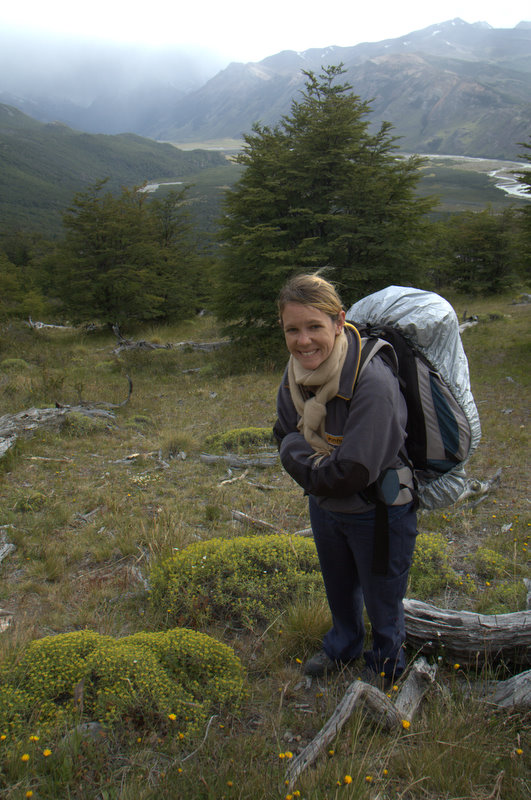 Jess Hiking Out In Cold Weather
Jess Hiking Out In Cold Weather
 Jess & Aaron, Parque Los Glaciars
Jess & Aaron, Parque Los Glaciars
 Jess & Aaron, Parque Los Glaciars
Jess & Aaron, Parque Los Glaciars
 White Horse Near El Calafate, Argentina
White Horse Near El Calafate, Argentina
 Flamingos In Lagoon, El Calafate
Flamingos In Lagoon, El Calafate
 Statue In Cementerio de la Recoleta
Statue In Cementerio de la Recoleta
 Eva Peron´s Marker, Recoleta, BA
Eva Peron´s Marker, Recoleta, BA
 Intricate Design, Recoleta, BA
Intricate Design, Recoleta, BA
 Doctor Scene On Crypt, Recoleta, BA
Doctor Scene On Crypt, Recoleta, BA
 Crypt For Family Drunk, Recolta, BA
Crypt For Family Drunk, Recolta, BA
 Sunday Market Wares, San Telmo, BA
Sunday Market Wares, San Telmo, BA
 Fruit Stand Near San Telmo Market, BA
Fruit Stand Near San Telmo Market, BA
Until next time, be safe.

January 25, 2010
Fun In Buenos Aires
We are having an excellent time in BA. This is arguably one of the most famous cities of South America, and as such, it is a great place.
Naturally, we have been walking our legs off in the last three days. BA is a moderately sized city of only 3 million folks, most of whom trace their ancestory back to Europe (mainly Spain and Italy). As a result, it definitely has a European flair to it. Also, many of those immigrants were blue collar workers, and BA is famous for its gritty feeling. That´s not to say that people here are particularly coarse or rough looking, but there are plenty of neighborhoods that seem quite rough, and even if you are in a very nice neighborhood, a rougher barrio isn´t too far off.
This was especially apparent yesterday when we decided to visit a colorful neighborhood south of the Microcentro (the center, where our hostel is located) called La Boca. The LP guide notes that it is "raffish to the core," a description that proved quite apt; the LP also noted on its map of the barrio that a good sized section of it is considered unsafe for tourists, the first time we have seen that on a map. Most tourists arrive in the most famous area of La Boca, called Caminito, on tour buses, from which they wander around a three block area painted bright colors in a bold attempt to attract tourists (which seems to work). Then they board their buses and head north again to the safer parts of BA. Jess and I decided to walk down to the barrio, partly because we didn´t know how to get onto a bus, but also because we are far too cheap. We just tightened our belts a little, hid the money better, and clipped my camera bag to my belt with a karabiner, and off we went.
It didn´t take long for us to get that sense of crossing the tracks (which in this case was actually going under a freeway); we left a neighborhood called San Telmo, which we had just finished thoroughly exploring and was crowded with tourists hunting for souvenirs in this huge Sunday outdoor market. Just past the freeway, we found ourselves in the real BA, where the Shirtless Ones of Eva Peron live. We were immediately and literally marked as outsiders; within a block or two we felt something wet on our backs. This young girl flitted around us, saying "Sucio, sucio (dirty, dirty)." There was obviously something going on with her, and we gave her a hard stare but didn´t stop walking at all. She moved on up to a companion ahead of us, and I took a look at Jess´s back, to find that the girl had squirted green chile on her; Jess confirmed my back was dirty as well.
So, this is a variation of a fairly common ruse in South America, very common in Bolivia and Peru. You are distracted by someone while their friend takes your wallet or bag; in this case, the girl would have offered to wipe us clean, while her friend would have swooped for my wallet. He would´ve gotten away with about $2 for his efforts. As we didn´t fall for the trick, they disappeared. Our friend Talie lost a bag this way in Peru; a distraction by one man in a cafe allowed another to snag her bag. It´s quite helpful to be aware of such tactics.
At any rate, the rest of the walk was uneventful, and we found that the rough neighborhood was still very clean and tidy, little trash about, and people were nicely dressed; families wandered around with babies and children, and people chatted outside of their houses. That´s not to say I wanted to be there after dark; we made our way to the Caminito area, walked all around and snapped the photos of the bright buildings and made another uneventful walk back up to the center. It was a bit enlightening, to have a snatch attempt made; again, it pays to be aware that it does happen.
Our exploration of BA has been fairly extensive. The first day was fairly relaxed, we probably only completed half of the walking tour, but we felt like we got the hang of the center. The second day was extremely long; we were out of the hostel for 11 hours. Jess had a bit of an Eva Peron focus for the day, so we went up into the trendy Palermo area, where Eva´s museum is. We spent about an hour there, after which I needed some coffee to wake up. We strolled all around Palermo, a fun area of cool cafes, expensive shops, and residences. We found a Chinese buffet, which to my delight was all-you-can-eat, for lunch. Then we went the Cementerio de la Recoleta, a famous cemetary that not coincidently contains the remains of one Eva Peron. The cemetary was fascinating, a necropolis of huge family crypts and ornate statues. We eventually arrived back at the hostel in the evening, and found our way to an Irish bar for a couple of beers and some hamburgers.
Of course, a visit to BA would be incomplete without a big steak dinner. Last night we went to a little steakhouse that the hostel folks recommended. I ordered a t-bone, Jess had a big rack of ribs, and we shared a bottle of Argentinian red wine. The total bill came out to be 128 pesos, which is about $32; a meal of those portions would have easily cost over $70 in the US. Argentina is known for its beef, for good reasons.
Today we head into Uruguay. We decided not to go to the capital, Montevideo, but instead to a smaller city closer to BA called Colonia del Sacramento. From there we hope to take a night bus up to Corrientes, on the Paraguayan border, where we will head north to the worldclass Iguazu Falls, which lies where Argentina, Brazil, and Paraguay all meet. We might be lucky enough to cross into Brazil for a daytrip, but apparently to enter Paraguay, we´ll need to buy visas, which will cost $100 each, so I´m thinking that we´ll just skip Paraguay. After visiting the falls, we´ll return to Corrientes and then head up through northern Argentina into Bolivia and eventually Peru. We have six weeks now to complete our trip.
Which I´m sure will fly by far too quickly.
Until next time, be safe.

January 22, 2010
Bittersweet Developments
We have had two developments in our plans for this trip, in the past couple of weeks. We find them to be a bit bittersweet.
First, we´ve decided that we won´t be able to successfully complete the initial goal of this trip, to visit all seven continents. We found that we weren´t making any headway in finding an affordable, time-conserving way to get to Antartica. In the end, we were looking at a minimum of $9000 between the two of us for a nine day visit on a cruise to Antartica. In the spirit of this trip, where we felt that we have been most fortunate to have had the experiences that we have encountered, spending so much time and money simply to reach the shore of Antartica to snap a picture and say we´d been there just lost relevance. We have had a wonderful trip, and loved every moment of it, so it doesn´t feel so necessary to try to reach Antartica, unless some new development such as a fund to get us there (pretty please?) suddenly pops up.
Hence our decision not to go to Ushuaia. We´d planned a visit to try to bargain with travel companies and get a good deal, but when we realized that we weren´t so dedicated to getting to Antartica, the idea of a 12 hour bus ride from Punta Arenas to the end of the Americas seemed a little pointless. By not going there, we have allowed ourselves more time (and money) to enjoy Argentina and the rest of our South America segment more.
The other development is that we now no longer have an open-ended trip. We finally decided upon a return date, and now have in our possession two tickets from Lima, Peru to Charlotte, NC. We will arrive in the US on March 5. The trip will come to an end, and back to reality we´ll go.
Or will it?
Until next time, be safe.

Finishing Up Patagonia
We have arrived in Buenos Aires early this morning. It was a long trip, not so much by the length of the travel, but just because of our exhaustion. We flew here from the port city of Rio Gallegos, which had such bad reviews in our book that we didn´t even bother exploring it. What was exhausting about the trip was that we took a mid-afternoon bus to Rio Gallegos, then sat in the airport from 7 pm until they finally boarded us at 3 am. Oddly, the plane was a half hour late taking off, even though it was only one of two flights in a seven hour period; it seems they had a difficult time boarding us. At any rate, regardless of the delayed departure, they somehow made up the time and even arrived in BA earlier than the 6 am arrival time, much to my sleep-deprived dismay. We figured out which bus would take us to the center, and arrived in the correct neighborhood, though I made quite a spectacle when I tried my best to squeeze my big bag out the door as quickly as possible, getting hung up on a handrail and knocking my glasses off in the process. It had to have been amusing, this disheveled homeless looking man with a huge pack trying to pop out the door.
BA is great so far. We´re midway through a walking tour, though the fact that I´m sitting in a computer lab right now shows just how serious we are about it. This is a big city for certain, and it gets some bad rap by people who just dismiss it as such. However, there is quite a personality about this city, an old, bohemian character that can frequently be noted by walking around. Our hostel has quite a character as well, very friendly folks and interesting art painted all along the walls. They were nice enough to hold our bags for us when we arrived at 8 am, though check-in wasn´t until 11 am; they even let us drink coffee (the cafeteria lady withheld the bread and jam though), which is the first time in 5 months that has happened. We´ll probably end up staying here in BA, exploring the city, finding as much tango, wine, and cool barrios as possible, for four nights.
As a matter of fact, Argentina itself has been as great as I was expecting it to be. My last entry was about hiking in the Torres Del Paine park. From Puerto Natales, we headed with our friend Talie down to the most southern city in South America, Punta Arenas, Chile (Ushuaia is the southern most town). Legend has it there are ropes along sidewalks to help pedestrians keep from being blown over by the frequent high winds. While we didn´t see any ropes, we did notice that the trees tend to grow at a slant, all in the same direction. We´d gotten mixed reviews on Punta Arenas, some people love it and some people hate it. Ultimately, Jess and I wanted to see the Strait of Magellan, which played a prominent part in a book about the history of circumnavigators, and so we went. I can see how people might not like Punta Arenas, if the weather were horrible, which apparently it can be. We were fortunate that our two full days there were spent under sunny if windy skies. It´s actually got a bit of pioneer charm to it. Better yet, the Austral brewery is there, and at 5 pm on weekdays they offer English language tours, including a decent sampling of all their brews. We love a good brew tour.
We sadly parted company with Talie at that point; she continued on to Ushuaia on the Tierra Del Fuego island, where she gleefully ignored a sign posted about her trail being closed and was rewarded with a couple of nights of solitary camping in a beautiful if forboding part of the world. As for us, we bused back to Puerto Natales and then on into Argentina, to the tourist trap of El Calafate. We were glad to be in Argentina, though sad to be leaving Chile (we were there a month to the day). It is our 17th country on this trip, and my 40th country outside of the US. On the other hand, we quickly ascertained that we needed to clear out of Calafate as quickly as possible. Walking down its one major street, one quickly sees what sort of town it is; the street is lined with chocolate shops, souvenir stores, and any other kind of kitschy or overly priced outdoor equipment that you can imagine. Kind of like Gatlinburg of Patagonia. It´s funny how frequently we find oursevles in these types of towns.
So, we stayed one night in the town, as it was nearly 8 pm when we arrived. The next morning, we immediately set out to buy tickets up to this crazy little village up in the mountains called El Chalten. After stocking up on some food supplies, we headed up to the town. It is the youngest town in Argentina, apparently born in 1985 based on some border dispute with Chile over who owns the 300+ glaciers in the area. The town itself is in the Los Glacieres Parque Nacional, an aptly named park that contains the famous climber´s peak of Cerro Fitz Roy, which is where we wanted to do some hiking. The town is obviously a frontier town, with no banks, post offices or similar expected businesses other than loads of hostels and a couple of dingy super-mercados; it even has a graveyard, empty as no one has died and been buried there yet, which speaks for its youth. But despite the persistent feeling that you are on a Old Western movie set, the town is great simply because it is the entrance into the hiking system of the park; you literally walk off of the streets onto trails and up into the mountains.
The park itself is free (besides the bus ride), an amazing difference from Torres, which sort of broke the bank. There is no entrance fee, and there is no charge for camping in the free campgrounds inside the park. On the other hand, the established hiking system is pretty limited, with a couple of campgrounds only three or four hours from each other, and the town pretty much three hours from any point on the hike that we took. Our hiking pals from Torres, Annabelle and Dan, hired a guide to take them further into the backcountry, which is recommended if you want to avoid the throngs of dayhikers coming into the park for the views. We weren´t up to exploring backcountry given our supplies and our lack of experience, so we stuck with the trails. It was enough of a challenge, as it turns out; what the Fitz Roy range lacks in technical trails, it makes up for in ferocious winds and rapid changes of weather that can go from bright sunshine to freezing rain and sleet being blasted into your face. It´s impressive. Ironically, between the hikes in Torres del Paine and Fitz Roy, this was the hike my mom worried the most about, as we were going it alone. That was before I informed her that camping in freezing cold a mere three hours from a warm hostel bed is self-inflicted punishment, akin to camping in your backyard in a blizzard, for the novelty of it all. That´s not to mention the hordes of hikers we met, which meant we were never really alone. That´s ok, though, mom.
Our first night we hiked up to a glacial lake, which was beautiful, though we had a late start and didn´t see much of the glacier or the lake that night. We had a cold night but I slept well, and in the morning, we woke up to brilliant sunshine. We lazily had breakfast and packed up, and hiked the four hours to the next campground, assuming we´d set up our tent and go further up the trail. All went well until about 45 minutes before the campground, when we came over a crest and found the wind blasting into our faces. We staggered through the freezing rain until we reached the campground, our pants wet, ice forming in my beard. It seemed strange to have such weather in January in the southern hemisphere, but this is what Fitz Roy is known for. By the time we set up the tent, we were freezing, so we hid in our sleeping bags for about three hours, trying to warm our limbs, until suddenly a calm arrived. We ventured out and went hiking up towards the Fitz Roy for about an hour; again we were driven back to the tent by a driving...snowstorm? We had a frigid dinner and ended up in our sleeping bags by 7 pm. We listened to huge wind gusts pounding our tent and driving sleet balls into its walls, until around 9:30 again there was an absolute calm. I went outside (Jess refused) and suddenly I found myself looking up at the massive Fitz Roy, which is so commonly veiled in clouds that many visitors never see it. It was gorgeous in the falling dusk, so I snapped a few photos and headed back to the sleeping bag, as a lack of wind didn´t stop the snow or the biting cold.
I woke up at 5:30 (no surprise given that we´d been in our sleeping bags since 7 pm). I looked out, and was surprised to see the outline of the Fitz Roy above. I decided against getting out of the tent for sunrise photos against the peak, figuring it would still be visible at 7:30 when it wasn´t so cold. I was wrong, instead finding a huge cloud bank looming in its place. We decided that indicated another storm was coming, so we quickly had breakfast and packed, and even so found ourselves being helped along by huge gusts of wind driving rain into our backs. At least it wasn´t in our faces. We soon walked out of the worst of it, which seemed to be concentrated in the valley below Fitz Roy, and the rest of the walk was really beautiful. Along the way to El Chalten, we kept passing folks who looked woefully unprepared for the weather further back, wearing minimal jackets and cloth shoes. Even those more appropriately dressed, I didn´t envy, because by the time we reached town and found a restaurant for a beer, the storm had followed us in and was pouring rain. Good day to leave El Chalten and Fitz Roy, I thought.
Back in El Calafate, we found that we´d made an error in our calculations, and that we had a spare day to spend in Calafate before we headed on to Rio Gallegos. That afternoon we tried to keep ourselves busy, which is difficult in a town with as little to offer as Calafate (it is strictly known for its easy access to Fitz Roy as well as the Perito Moreno Glacier, which draws people from all over the world; we had decided against paying $45 each to see the glacier, because nothing will beat our view of the Glaciar Grey in Torres del Paine). That night in the hostel, I was awoken in my bunk bed by incessant itching, the sypmtoms of bedbug-infested sheets; I ended up with a stripped bed in my travel sheets, with plenty of little bumps to prove the issue, though I didn´t look like I had in Morocco after such an attack, where I could have been mistaken for having chicken pox. Fortunately the next day I was able to move to a different bed, and Jess and I spent the day relaxing in town, eating and drinking and reading all day. Of course, the next day we headed on to Rio Gallegos, to catch our flight to BA.
Thus ends our saga in Patagonia. It took me three visits to Chile to finally get down there, but it was worth every penny spent and the years of waiting. It is one of those places, where in the midst of a constant wind dreading your hair for you and a persistent chill despite being summer, you can´t help but think that it is a real special place, magical in its own way.
Until next time, be safe.

January 13, 2010
Photos From Torres del Paine
Pictures just don´t do the Torres del Paine any justice. Here are my best efforts to attempt that.
 Aaron & Jess Near Refugio Peohe
Aaron & Jess Near Refugio Peohe
 Ghostly Peaks, Valley del Frances
Ghostly Peaks, Valley del Frances
 Possibly The Massif, Valle del Frances
Possibly The Massif, Valle del Frances
 Morning View From Tent, Los Cuernos
Morning View From Tent, Los Cuernos
 Walking Towards Refugio Chileno
Walking Towards Refugio Chileno
 The Torres del Paine In Clouds
The Torres del Paine In Clouds
 Jess & Aaron At Torres del Paine
Jess & Aaron At Torres del Paine
Until next time, be safe.

Trekking The Circuit
We´re back in Puerto Natales for a day of relaxation and reorganization, after spending eight days trekking in the nearby Parque Nacional Torres de Paine. What an incredible week it was!
We started out last Tuesday morning, catching a bus from Puerto Natales that in the traditional South American fashion was a half hour late and then circled town a couple more times picking up various hikers rather than departing from a central location. Two hours through some very bleak territory later, we arrived at the park, where knowing that we would have to pay $30 each to enter the park (after paying $30 each for the bus ride) didn´t make the transaction less painful. From there, it got better and better.
We started our hike from Laguna Amarga with a woman we met on the Navimag ferry, a 63-year old fellow Coloradoan called Talie (you can see a link to her blog on the right side bar). We set out on the Circuit, going in the counter-clockwise direction (see a map here). Torres de Paine has over 200 km of trails, but the most famous is the W, which takes hikers along the front side of the massive towers, and up two valleys for close views of the peaks, hence the name. The Circuit includes the W as well as continuing along the backside of the peaks. This section of the park is equally beautiful as its famous counterpart, but has fewer people given the total distance as well as much fewer amenities. The fact that it was far less crowded was the great attraction, and so we set out, covering nearly 15 km that first day up to the first campground, Campamento Seron. This little campground was beautifully situated in a large field of white daisies, and though a harsh wind blew throughout the night, it was a favorite campground of ours. We also met up with a British couple we´d met on the ferry, Dan and Annabelle, who had started earlier but were camping at Seron. Our hiking group was thus complete.
The next day was not as kind as that first day. We walked about 30 km that day, more than 18 miles, with our bags fully packed with food for the trip. Consider that I arrived in Chile out of shape, and then had a week in Santiago, a week in Loncoche, and then five days en route to Torres de Paine where I had very little activity; needless to say, it was an exhausting day. We first came to the Refugio Dickson, which sits near a glacier and has a pleasant little meadow to lie in the sun. The trip from Seron to Dickson was long, but mostly flat and very beautiful, and if we´d chosen to to stay at Dickson, it would have been a perfect day of hiking. We chose to continue to the next campground, Los Perros, because though it was only 10 km away, it was a stopping point, as it sat at the bottom of the Circuit´s pass, the Paso John Gardner. It was recommended that we take on the pass starting in the morning, when its snowfields would be firm; thus we took on 30 km to reach Los Perros that evening.
Leaving Refugio Dickson had us start up a steep valley almost immediately. Having already walked 19 km, that had us staggering quite quickly. From there, it was more of a mental game, keeping our feet going. We climbed up and up, and eventually came to a bridge that seemed to fit a description of one that was only 15 minutes from Los Perros. A quarter hour later we realized that not only was it not that particular bridge, but we had a full hour ahead of us, and we had to climb up a huge pile of glacial rock to boot. At one point, on our final break, Jess and I were curled up fetal positions, ready to spend the night there on the rocks if necessary. Further on, as we came up to one really amazing glacier that was squeezing through a little gap in a rock face, a pale green lake below it, and a rock debris field all around it, there was just a sense of palpable isolation and desolation. A terrific Patagonian wind howled against us, and it seemed that we were at the end of the world (which in a sense we were the entire trek). Just when it seemed like I´d have to lay down on the rock field and stay the night there, we staggered into Los Perros, an equally bleak campground but such a beautiful sight to behold. We set up our tent, cooked a bit of pasta, and collapsed in our sleeping bags.
Climbing the pass the next morning was an absolute highlight of the trek. We climbed through a bog out of Los Perros, which gradually became alpine scrubland, and eventually changed to windswept rock fields and snowfields. We slowly made our way up, thankfully with little wind, and around noon we crossed through the pass. There, on a football field-sized flat area, against a roaring wind that finally had found us, we looked down on the magnificent Glacier Grey, which stretched out before us like blueish-white ocean. The view of looking down on such a glacier was a first for myself and Jess, and it was more breathtaking than the wind. We took our shots and then retreated down the long descent to the next camp, Campamento Paso.
The next day was the Ladders Day, which took us on a route rumored to have steep 50-foot ladders dropping in and back up out of ravines. It was a short day in distance, but we figured we might need plenty of time for the ladders. We found the two ravines with a ladder each, but that was rather anticlimatic, as they were quite short and easy to climb. The walk itself along Glacier Grey, which took us down to the front of the glacier near Refugio Grey, was really the highlight of the day; we consistently had this massive, almost surreal glacier to our right side as we hiked along. It was a beautiful and fairly easy day of walking; at the refugio we found hot showers and were able to clean ourselves for the first time in four days, though the cold water was gone by the time I took my shower and the water too hot to rinse off the soap, leaving me either the cleanest or dirtiest person in our group, depending on how you think of it. Jess, Talie and I had an expensive dinner at the refugio; being a big piece of turkey, it was the first piece of meat we´d had since our night in Puerto Natales.
The next day was another long day, one of our two roughtly 18 km days. We hiked downhill to the Refugio Peohe, where a boat drops off and picks up hikers wanting only to walk the W and takes them across Lago Peohe to a bus. It was quite a ritzy place given its isolation; going in for some food, I found internet in the lounge which someone had neglected to log off from, and I quickly snuck in to send an email off to our folks to let them know we were doing well. Then we continued on to our campground for the night Campamento Italiano, a rather primitive place that sat at the bottom of the first valley of the W route, Valle del Frances. That allowed us to get up the next morning and head up the valley without our packs to the end of the trail for a good view of some of the iconic towers. Along the route were a couple of glaciers that hung tenaciously from the walls of the valley, occasionally loudly groaning with tension and giving us hope of seeing some massive wall of ice calve off and drop into the valley. Once back at our tents, we loaded up and went a further 5.5 km to the Refugio Los Cuernos.
Spending the night there allowed us to make another long trek across the 11 km front of the W to the eastern point of the W, which plunged into the Valle Ascencio to the Mirador Torres, the viewpoint right at the base of the majestic Torres Del Paine. These massive spires of stone were certainly worth the hike, but what a hike it was. We ate the kms up getting along the front, going about 14 km to the Refugio Chileno. We felt pretty good at that point, and we´d been told that it was a simple meander up the river to our final camp, the Campamento Torres, by some Aussies. Those guys were either cruel or totally full of crap, because that last 3.5 km was no meander but for me, a step-by-step struggle up and down the sides of endless ravines. Eventually we arrived in the camp, weary but happy, and set up our tents. Before we had dinner, we set out for the Mirador Torres, an additonal kilometer straight up. We found ourselves some of the last folks of the day there, and enjoyed the views as well as occasional bursts of sunlight until a snowstorm and the blustery wind pressed us back down to our tents. There, we´d planned on a night of cardgames, but that campground was the coldest we´d been to, and once we got bundled up in our sleeping bags, wrapped in all the layers we had, no one was willing to face the cold again for games.
The next morning Dan and Talie headed back up to the Mirador at 4:30 am to try to catch a chance at seeing the glow of the sunrise off of the towers, but myself, listening to the snow pellets hitting the side of the tent, I opted to stay in my relatively warm sleeping bag, though it had been a very cold night. After breakfast, we happily left the cold campground and retraced our tracks back to the Refugio Chileno, and then on down to the Hosteria Las Torres, passing crowds of day hikers making their way from the ritzy hosteria to try to see the towers (a long, steep 18 km day hike). By that point my knees were giving me troubles, so I must have looked like quite the character staggering down the slope, wearing the same pants that I had started in eight days before, dusty and windblown. At the hosteria, after being in the backcountry for more than a week, I found myself quite shocked when they tried to charge $4 for a Snickers and $5.50 for a hot chocolate; I had to leave, before they started charging me to breath the air.
We eventually arrived back at Laguna Amarga, where we calculated from the large map there that we´d traveled a total distance of 136 km, which is about 82.3 miles. We had set out on a Tuesday and returned the next Tuesday at almost exactly the same time of day, roughly at noon. We waited for our bus, which brought us back to Puerto Natales. After sorting out our hostel situations and taking much needed showers, we re-gathered for a celebratory dinner of big hunks of meat and plenty of beer, which I´d been thinking about since the second day of trekking.
So, the trek has been a true highlight of Jess and I´s entire journey. We saw some of Chile´s finest, most enchanting landscapes, and even better, we had some great hiking partners. Dan, Annabelle, and Talie really helped us keep going, and made this trek, which was Jess´s first, a great experience.
Until next time, be safe.

January 04, 2010
Photos From The Ferry Ride
Ferry To Puerto Natales
We have arrived in the little port town of Puerto Natales, famous for its close proximity to the world class national park of Chile, the Torres del Paine Parque Nacional. We just arrived a few hours ago.
The time since Christmas, nearly two weeks ago now, has gone by in a flash. We stayed at our friends´ house in Loncoche until January 1st. It was a very relaxing time, we slept in late, chilled with the family, played with Carla´s son, and walked around the very sleepy city (?) of Loncoche. We managed to get in a day trip to Temuco to pick up some woolen supplies for our time here in Patagonia, a day I enjoyed thoroughly as we went to see the new movie Avatar (which was excellent by the way). We also went one day to Valdivia, to walk around in that very scenic little city. Of course we stayed with the family for New Years, which we celebrated by a huge meal about 10:30, then a few drinks until midnight. Then we headed down to the one big bar in Loncoche, where apparently the entire town had crowded inside. It was so hot that my glasses fogged up whenever I would come in from outside, where a light rain was falling. (So much for warm holidays--the clouds never broke over Loncoche). We danced there until 5:30 am, then went back for a half hour of sleep before catching a bus to Puerto Montt at 7:30. Needless to say, we were a little exhausted by that point, carrying on merely by the intrigue of finally getting an opportunity to go to Patagonia.
So, in the afternoon of January 1st, we tiredly boarded the Navimag ship as it sat in the port of Puerto Montt. I´d read a bit about the ship, and had my preconceptions of what our trip might entail. For example, in the winter time, when there aren´t many passengers, part of the cargo might include a large herd of cattle, which I can imagine would taint a four day journey a bit. Actually, the ferries themselves are really cargo ships, which at some point somebody had the bright idea of outfitting them and charging folks large sums of money to ride down to Patagonia. Ourselves, we opted for the cheapest option, which had us sleeping in a 42-bed bunk room. Again, I had a picture of this big, metal, open room, lined with metal bunks that had little mattresses on them.
Gladly, I was quite wrong about the ferry. Indeed, it was a cargo ship, it had a large area where large trucks could be pulled in for the trip (or a big herd of cattle). It certainly did not have the appearance of a cruise ship, more like a ferry ship that takes people from one place to the other. On the other hand, our bunks were in a maze of hallways that seemed closed off from other areas. We had perhaps 14 bunks in our little corner, and Jess and I´s bunks only faced two other bunks, which happened to be occupied by an American couple from Boston. Even better, the bunks were not metal but rather attractively decorated with wood. There were large lockers at the ends of the bunks, and curtains could be closed, which kept the bunks very dark at night. So, it was quite comfortable in the living quarters.
On the deck abover our quarters, there was a large dining hall, where we ate three meals a day, as well as watched a couple of really good Chilean movies and attended a couple of talks about the nature around us, which were a little less quality. On the top deck was a small pub, with tables as well as couches. Outside of the pub was a large viewing area, and you could walk around all of the decks as well as up to the front of the boat for good views. Of course, the best part, indeed the attraction of the ferry ride, was the scenery. This was really breathtaking, as the ferry cruised down the channels and fjords of the Chilean archipelago. We passed the large island of Chiloe and then continued on down, turning amongst of the many islands. Soon after Chiloe, signs of humanity disappeared and were replaced by roadless, unadultured nature. This started as dense green forests, and the further south that we went, the more snow began to appear on the peaks above the shoreline.
The second day was the worst, as we knew it would be. For twelve hours we would leave the calm waters of the channels and head off into the rough, dark oceans that notoriously lie off of the Patagonian coast. So, for twelve hours, we endured huge swells, which really helped define how large our ferry was. Before, I´d considered it fairly large, big enough that I didn´t think that most waves would be felt, unless they were big. Perhaps this is true, but either the ferry wasn´t as large as I´d thought or the waves were just that big (or both), because we felt the swells just fine. Sitting in the dining room playing cards, we could always judge the biggest waves by how much they rattled the dishes in the kitchen. Outside on the front deck, we could watch as the bow rose high above the water and crashed down in the next trough, sending foaming water spraying out from the sides. Jess and I did fairly well through the afternoon, though the hours seemed to drag on terribly. During dinner, though, we looked up at each other and realized that we both were feeling the effects of a chicken leg on our tenuous stomachs. We survived, though, without either taking any medications or vomiting off the side of the boat, the latter of which I am most happy about.
The third day was really the most spectacular. First, it had long periods of sunshine, whereas we´d pulled out of Puerto Montt under cloudy weather, which for the first two days only included periodic rain and gusty winds, especially once we had left the channel for our ocean segment. So, the sunshine was most welcome. Also, the highlight of the day was a visit to a glacier, which was really stunning. We could see the glacier from a distance, and as we drew closer, we started to notice little iceburgs bobbing in the water. These grew larger the closer we came, and some were really large. The boat was able to get quite close to the glacier itself, and of course I took more pictures than necessary. It was very difficult to stop snapping shots of the pale blue ice, with its towers and valleys. The glacier was immense, but we learned later that it is only a small part of a massive ice field, so one could say that we only saw the tip of the glacier, to warp a phrase.
Besides the nearly constant scenery of the trip, we also met several memorable people, which will probably mean more to us in the long run that the views we had. There were our Bostonite bunkmates, who taught us to play Rummy500. We met a couple from Britain and an Irish lassie who we enjoyed playing Bingo with the last night. We also met a fellow Coloradoan, a lady who inspired us with a number of great stories as well as a raw passion for the kind of travel life that we love. I can´t reveal what we have been inspired to do now; our parents will have to find out about that trip once we plan it out a little more.
Now we are getting ourselves situated for our next adventure, which is a hike in the Torres del Paine. We have to decide how long of a hike we will be taking. There is the shorter option, the "W," named for the pattern of its route. This hike takes 3-5 days, we would probably take four days to complete it. There is also the Circuit, which includes the W but returns on the backside of the spiral peaks, which takes 7-8 days to complete. At this juncture, I´m thinking that we will just take the W and see how we feel at its end about finishing off with the Circuit. We easily found a hostel here in Puerto Natales (they were waiting with a pickup truck when we got off of our ferry), and tomorrow morning we´ll leave all of our unnecessary belongings at the hostel and set off into the wilderness. This park is supposed to be one of the best parks in South America, so I am getting very anxious to get on the trail.
Especially after four days on a ferry.
Until next time, be safe.

December 27, 2009
Christmas In Chile
We have had a very good time in the past ten days that we have been in Chile. It is the third time that I have visited this country, and Jess has been here once before, but perhaps we return to Chile because of its charm. That is highly likely, as this is one of our favorite countries.
We have also returned to Chile during this trip in particular to visit our friends that we have here. I´ve known a family down here for almost eight years. Back in 2002, I came down to Chile for the first time with a high school friend who was visiting family. After more than a month of being in Chile, which was the first country I visited solo, I was getting a little desperate for a little English. I didn´t speak a lick of Spanish, and no one in the tiny town of Maullin that I was staying in spoke any English besides my friend, who had more to do than translate for me. Then a trio of Claudio´s cousins came through the town to visit, as they had been a bit more south on the rustic island of Chiloe camping and decided to visit their family. Hence I met Carolina, Carla and Rodrigo, and when they offered for me to come with them to their home in Loncoche, I jumped at the chance (Carolina was studying to be an English translator). Nearly a decade later, I still enjoy their friendship and generorsity immensely, and it was a no-brainer to spend the holidays with them this year.
It was to Rodrigo´s apartment in Santiago that we found ourselves after our trip from New Zealand. We haven´t been to Santiago since January, 2008, but getting from the airport to his apartment was surprisingly easy, though we had to take a bus and then catch a metro ride, all after dark. We even knew how to walk from the metro station through the neighborhood to reach the apartment. It was nearly like coming home. It was nothing like my first trip to Chile, where I realized about an hour outside Santiago how big it was (as I opened my Lonely Planet guide for the first time); I must have been quite a humorous sight on the bus into the city, frantically trying to figure out a place to stay, looking around in a panic as I noticed there wasn´t a word in English to be found. Arriving in Santiago this time was more like arriving at a home airport, very relaxed and comfortable; it was the first time in four months that we have felt so chill walking out of an airport into a city of millions of inhabitants.
We ended up staying in Santiago for about a week. We kept busy most of that time, but we struggled a little in that it seemed like we were stranded. We´ve been continuously on the move for four months now, as of December 26th, and we have rarely stayed in the same spot more than a few days. So, being in Santiago, a city that we´ve visited no less, seemed like we´d lost the wind in our sails. That sounds very dramatic, but it was a strange change of pace, even though we were only there for a week. At the same time, we were shifting from being in the West Pacific time zones (i.e. Australia and Asia), where we were eighteen hours ahead of the East Coast of the US to Chile, where we´re only two hours. That meant that suddenly we found ourselves staying up until two or three in the morning, then sleeping until the afternoon. I´m not going to lie and say that we get up super-early every morning, but typically we are up and moving by 9 am at least. It´s a shock to get up at 1:30, especially when you realize that most of the day is already over. This trip is flying by too quickly as it is to waste any time.
We struggled a bit with that, but as I said, we kept fairly busy, particularly in the evenings. Santiago gets a bit of a bad rap, as people tend to compare it to Buenos Aires as the two most developed capitals in South America, saying that Santiago is more of a worker´s city while BA is the beautiful, bohemian capital. We haven´t reached BA yet (though we will be there by the end of January), so I can´t make the comparison, but I´ve always liked Santiago and found it to be amply exciting, lively, and beautiful. Carolina is always a good host, and this time she took us out most evenings. We went to a tango bar one night, a classic night out in S. America, and probably my favorite in Santiago. The folks dancing in the bar obviously have spent a great deal of time working on their tango skills, including one old couple decked out entirely in white (they always dress in a single color); those two took their tango back to the early days of the dance, when it was being created in the dark, sweaty brothels of BA. Watching a couple likely in their 70s spicing up the floor with the kind of inappropriate grabs and dramatic flair that most of the other (younger) couples wouldn´t try was great. Besides, what I really like about tango is that the ambience of the dance takes you back in time, so despite the modern dress of the dancers, you can easily imagine being back in the 40s and 50s (the club was more than a bit old-school as well).
On other nights, we went out dancing, or to see a live band, or to eat a midnight empanada or completo (the delicious Chilean hotdogs, which are loaded down with sauerkraut, mayo, guacamole, ketchup, and other unhealthy condiments). One night Carolina had a friend over who does pedicures and manicures in a little shop in a metro station. The idea was for Jess and Carolina to have their nails done. Somehow, this girl, Sylvana, decided to tackle the issue of my feet. In the best of times, the bottoms of my feet are a tortured landscape of callouses and dry skin, and four months of being on the road hasn´t done much to improve that. Sylvana tackled the challenge without hesitation, breaking out an electric drill fitted with a spinning emory board to get the first several layers off, then working on it by hand. She shaved off what looked like the tissue equivalent of a toe, and I assured her that I´d do my best never to let my feet to return to such a desolate state again. Then we all went out for completos.
Despite how much fun we were having (or perhaps because of it, as we tended to be up very late having fun), we eventually came to the point that we felt like we needed to get out of Santiago for a day, to feel like we were still on a long trip. So, we made a day trip to the city of Valparaiso, about two hours away on a bus from Santiago. There we spent the day exploring this city, which I was told to visit on both previous times I´ve been in Chile but never did. Valparaiso has a bit of an edge to it, for even the LP guide states that some of Chile´s worst slums are on its periphery. Still, it is a cool city, with a very artsy bohemian character, which is best found by riding one of its many funicular cars up to some of the hills in its center. There, wandering through the brightly painted wooden or corrugated metal buildings, with a grand view of the city´s center and the ocean beyond, Jess and I happily spent a day, exploring alleys and shops, eating a huge plate of pork, eggs and fries called chorillana, and dusting six days of dust off our shoulders. We just had to remember to turn back when the neighborhoods turned from funky to really funky.
On Christmas Eve, we headed south, catching a ride with Rodrigo in his car. The trip took more than eight hours, but we talked and laughed the whole time, which made the journey go by very quickly. The road down to Loncoche was a very impressive, smooth, four-lane highway; I was a bit surprised by the large number of tollbooths that we had to go through, each charging $4US, which became expensive quickly. We arrived in Loncoche around 10:30, to find that everyone was waiting for us, including Carla´s son Luciano, who turns 5 in a month. We ate a huge meal, of chicken, beef, lamb, salad, potatoes, and more, which made the four of us travelers very happy after our trip. Then we took Luciano outside to look for Santa, though he is getting to the point that he is very suspicious of Santa. Once Carla had put the presents under the tree, "Santa" called Rodrigo´s cellphone and we hurried back to the house, where flour footprints led to the tree. Luciano of course took the biggest haul in terms of gifts, but even Jess and I received some nice presents, from our South American family.
Christmas was a very lazy day, though it wasn´t so warm. Since we arrived in Loncoche three days ago, the weather has been quite cloudy and cool, requiring sweaters for outdoor ventures. So, technically our plan for a warm Christmas didn´t come through, for the weather seemed more like that of the northern hemisphere. We ate a couple of times again on Christmas, and Jess and I walked off some of our Christmas calories around town. Christmas in Chile is the same as what most people would expect it the world around - time spent with family and friends. We were very fortunate (and happy) to have had the opportunity to be here with this family for Christmas, because although thanks to the creators of Skype we were able to chat with our families in the US, the distance can still definitely be felt, and I think that hanging out in a hostel somewhere would have been quite depressing.
As for our communication skills, Carolina has been giving both of us Spanish lessons. I´m more impatient and some might say lazy, but Jess has been working quite hard to improve her Spanish skills. Of course, being in South America for what looks like the next two months will provide plenty of opportunity to improve our Spanish, but we won´t have Carolina along with us to teach all of the intricacies of the language that we need, or to make the frequent corrections. In fact, we have purchased tickets on the Navimag ferry that travels from Puero Montt to Puerto Natales. We´ll leave Friday, January 1st, and arrive in the Patagonian town on the 4th. Our brief sojourn with our friends here in Loncoche is quickly coming to an end, a fact that is neither lost on us nor one that makes us happy. Still, we´ve had quite a good time with our friends here, ensuring this won´t be the last time we see them.
Until next time, be safe.

December 24, 2009
Merry Christmas!
We are in Santiago, but later today we are heading south with our friends to their parent´s home in Loncoche. We´ll celebrate the holiday there with them. I´ll post about spending Christmas in South America later this weekend.
In the meantime, Merry Christmas, and a Happy Holidays for all! We wish everyone the best from here in Chile!
Until then, be safe.

